What types of antibiotics are there. Uncovering the Varieties of Antibiotics: Exploring Options for UTI Treatment
What types of antibiotics are available to treat a urinary tract infection (UTI)?. Discover the different antibiotic options, their common side effects, and strategies to prevent antibiotic resistance and recurring UTIs.
The Diverse Landscape of Antibiotics for UTI Treatment
Urinary tract infections (UTIs) are one of the most prevalent types of bacterial infections, affecting millions of individuals annually. When it comes to treating UTIs, healthcare providers have a range of antibiotic options at their disposal. Understanding the diverse array of antibiotics and their respective characteristics is crucial for making informed decisions and ensuring effective UTI management.
Common Oral Antibiotics for Uncomplicated UTIs in Women
For most uncomplicated UTI cases, the following oral antibiotics are commonly prescribed:
- Trimethoprim-sulfamethoxazole (Bactrim, Septra)
- Nitrofurantoin (Macrobid, Macrodantin)
- Fosfomycin (Monurol)
- Cephalexin (Keflex)
- Ciprofloxacin (Cipro)
The choice of antibiotic will depend on factors such as the patient’s medical history, regional patterns of antibiotic resistance, and the specific bacteria causing the infection. Finishing the entire course of antibiotics is crucial to ensure complete eradication of the infection and prevent recurrence.

Understanding Antibiotic Side Effects and Resistance
While antibiotics are effective in treating UTIs, they can also lead to side effects and contribute to the growing problem of antibiotic resistance. Common side effects of UTI antibiotics may include nausea, vomiting, diarrhea, and skin rashes. Healthcare providers must weigh the potential benefits and risks when prescribing antibiotics, and patients should report any adverse reactions promptly.
Antibiotic resistance occurs when bacteria develop the ability to survive and thrive despite the presence of antibiotics designed to kill them. This phenomenon poses a significant challenge, as it can limit the effectiveness of available treatments and lead to more persistent or recurrent infections. Strategies to combat antibiotic resistance include responsible antibiotic use, proper hygiene, and the development of new antibiotic options.
Exploring Novel Antibiotic Therapies for UTIs
As the threat of antibiotic resistance grows, researchers and healthcare providers are exploring alternative and emerging antibiotic therapies for UTIs. These newer options include:
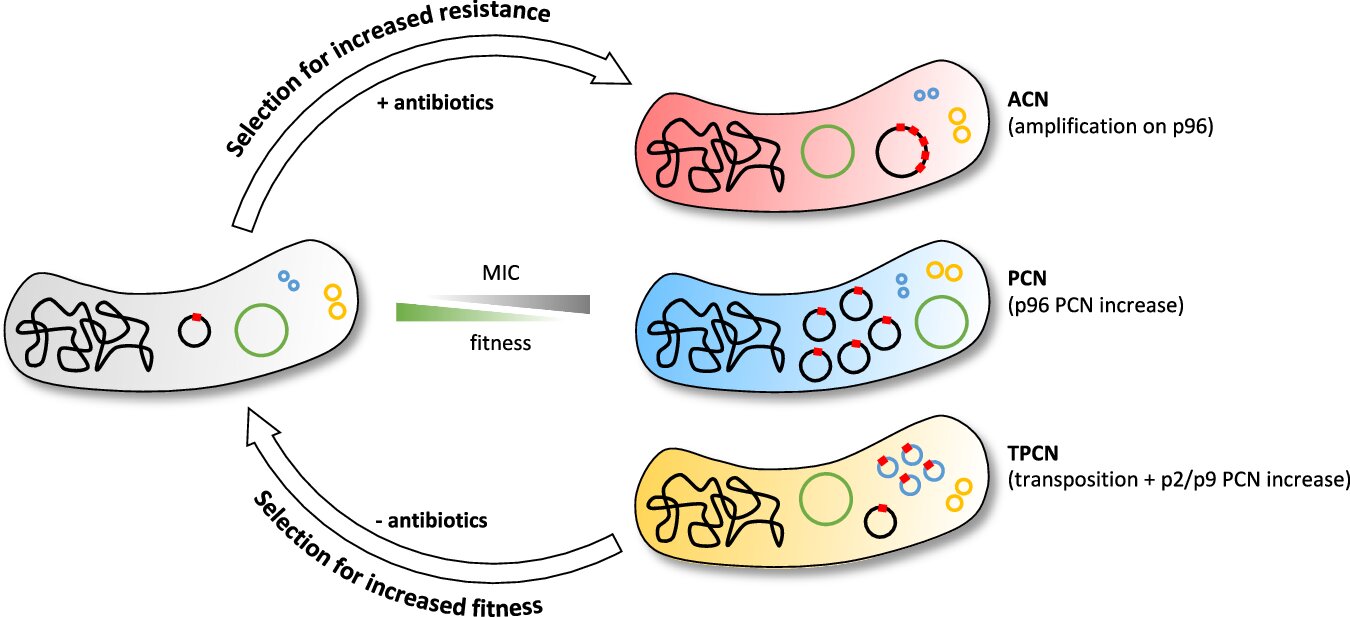
- Combination antibiotics
- Targeted antibiotics that specifically target the bacteria causing the UTI
- Antibiotic alternatives, such as antimicrobial peptides or bacteriophages
These innovative approaches aim to provide more effective and tailored treatment options, while also reducing the risk of antibiotic resistance.
Managing Recurring and Complicated UTIs
For individuals who experience recurrent or complicated UTIs, the treatment approach may differ from that of uncomplicated cases. Healthcare providers may recommend additional diagnostic tests, such as urine cultures, to identify the specific bacteria causing the infection and guide the selection of the most appropriate antibiotic. In some cases, longer treatment durations or alternative therapies, including prophylactic antibiotic use, may be necessary to prevent further recurrences.
Exploring Non-Antibiotic Approaches for UTI Management
While antibiotics remain the primary treatment for UTIs, there are also non-antibiotic options that can be considered, either as adjuncts or alternatives to traditional antibiotic therapy. These include:
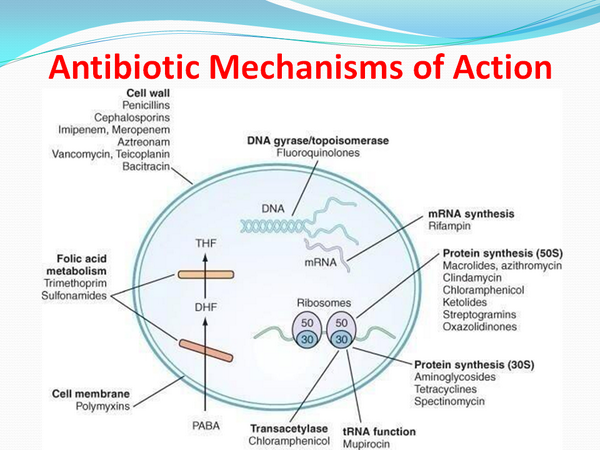
- Cranberry products: Certain studies suggest that cranberry supplements may help prevent UTIs, particularly in women with recurrent infections.
- Probiotics: Some research indicates that probiotics, which are beneficial bacteria, may help maintain a healthy urinary tract and potentially reduce the risk of UTIs.
- Lifestyle modifications: Staying hydrated, practicing good hygiene, and avoiding contraceptive methods that increase the risk of UTIs (such as diaphragms) can also be beneficial in managing UTIs.
Conclusion
Urinary tract infections are a common and often recurrent health issue, but the good news is that there are a variety of antibiotic options available to effectively treat them. By understanding the different types of antibiotics, their potential side effects, and strategies to combat antibiotic resistance, individuals can work closely with their healthcare providers to find the most appropriate and effective treatment plan for their UTI. Additionally, exploring non-antibiotic approaches, such as cranberry products and probiotics, can complement traditional treatment and potentially help prevent future UTI occurrences.

Antibiotics For UTI Treatment: What Are My Options?
Medically reviewed by Leigh Ann Anderson, PharmD. Last updated on July 29, 2021.
What is a UTI | Which antibiotic to use | Common side effects | Antibiotic resistance | New antibiotics | OTC antibiotics | Recurring UTIs | Treatment without antibiotics | Cranberry juice | More resources
What is a urinary tract infection (UTI)?
If you have ever experienced the frequent urge to go the bathroom with painful and burning urination, you have probably experienced a urinary tract infection (UTI). UTIs are one of the most common types of infections, accounting for over 10 million visits to health care providers each year. Roughly 40% of women experience a UTI at some time, and in women, it is the most common infection. Healthcare costs related to UTIs exceed $1.6 billion per year.
A urinary tract infection (UTI) can happen anywhere along your urinary tract, which includes the kidneys (the organ that filters the blood to make urine), the ureters (the tubes that take urine from each kidney to the bladder), the bladder (stores urine), or the urethra (the tube that empties urine from the bladder to the outside). Most UTIs occur in the bladder and urethra. Common symptoms include frequent need to urinate, burning while urinating, and pain in lower abdomen area.
Most UTIs occur in the bladder and urethra. Common symptoms include frequent need to urinate, burning while urinating, and pain in lower abdomen area.
There are different types of UTIs based on where the bacteria goes. A lower urinary tract infection occurs when bacteria gets into the urethra and is deposited up into the bladder — this is called cystitis. Infections that get past the bladder and up into the kidneys are called pyelonephritis.
Urinary tract infection symptoms may include:
- Pain or burning upon urination
- A frequent or urgent need to urinate
- Passing small amounts of urine
- Blood in the urine or or pink-stained urine
- Urines that looks cloudy
- Strong-smelling urine
- Pain, cramping in the pelvis or pubic bone area, especially in women
Upper UTIs which include the kidney (pyelonephritis) may also present with symptoms of fever, chills, back or side (flank) pain, and nausea or vomiting.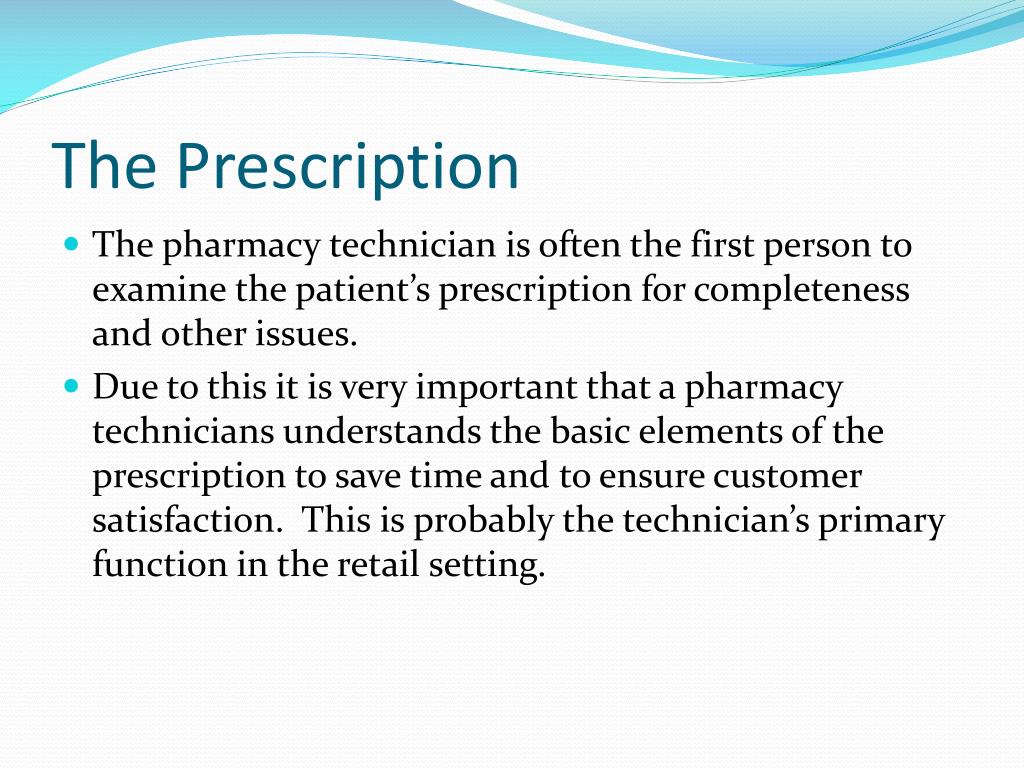
Older patients may have an atypical presentation that includes altered mental status, lethargy, and weakness.
An infection of the tube that empties urine from the bladder to the outside is called urethritis, or an inflammation of the urethra. Urethritis symptoms can include burning with urination and a discharge. Urethritis is often caused by a sexually transmitted infection and may require a different antibiotic than those used to treat UTIs.
Causes
Most UTIs in women (roughly 85%) are caused by a bacteria known as Escherichia coli (E. coli). Other types of bacteria, such as Staphylococcus saprophyticus may infrequently be present.
UTI symptoms in women and men are similar. However, urinary tract infections occur more frequently in women than in men. This is because a woman’s urethra (the tube that empties urine from the bladder) is shorter and closer to the anus than in men, allowing easier entry of bacteria like E. coli into the urethra.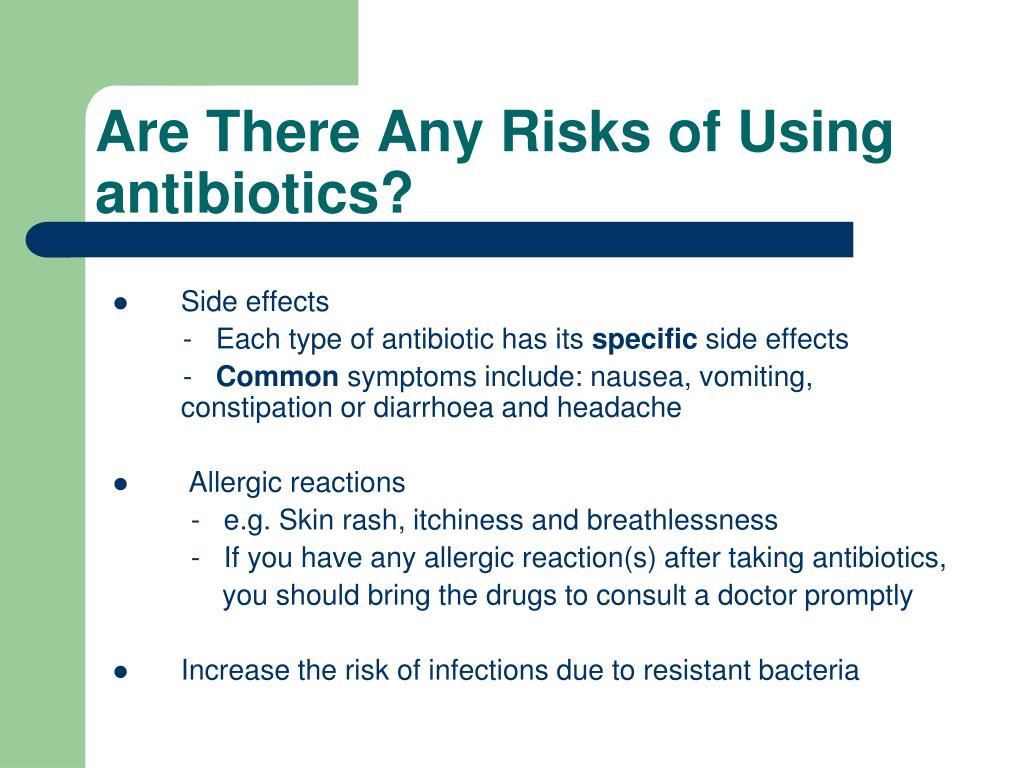
Menopause, lowered levels of estrogen, and elevated vaginal pH also increase the risk of a UTI. Women are also more likely to get an infection after sexual activity or when using a diaphragm and spermicide for birth control.
Other risk factors for the development of UTIs include catheter use, urinary tract structural abnormalities, diabetes, and a suppressed immune system.
Which antibiotic should be used to treat a UTI?
There are multiple types of antibiotics used to treat urinary tract infections (UTIs). Different treatments may be recommended in different areas of the country based on regional patterns of antibiotic resistance.
Most patients with an uncomplicated UTI will begin treatment without any special diagnostic test, although a urinalysis may be performed by taking a urine sample. In a urinalysis, the chemical components of the urine are determined, and the doctor may look at urine color, clarity, and a view a sample under the microscope. A urine culture may be order, too, but is not always needed to start treatment.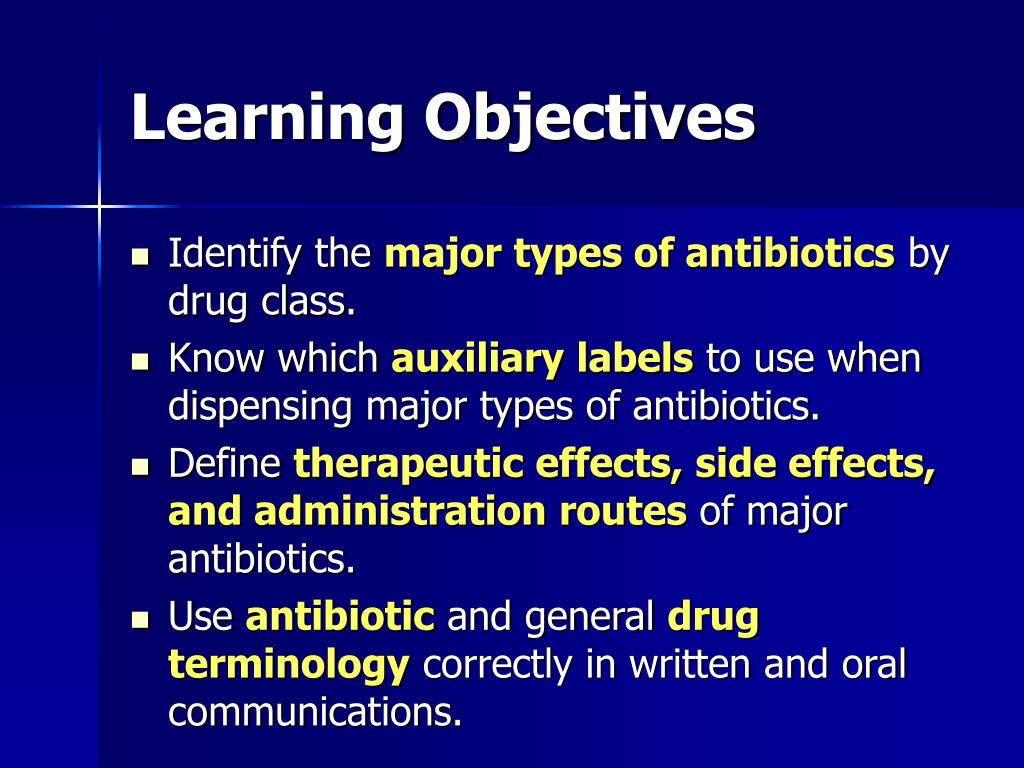 A urine culture can define the specific bacteria causing the UTI in more complicated cases or in the case of treatment failure.
A urine culture can define the specific bacteria causing the UTI in more complicated cases or in the case of treatment failure.
Symptoms like burning and stinging while urinating will usually clear up in within one day after starting treatment. Be sure to finish your entire course of medication. If symptoms are still present after 2 to 3 days, contact your healthcare provider.
More extensive diagnostic procedures or imaging tests like an X-ray may be required if you continue to have frequent UTIs.
What oral antibiotics are used to treat an uncomplicated UTI in women?
The following oral antibiotics are commonly used to treat most uncomplicated UTI infections (acute cystitis):
Your doctor will choose your antibiotic based on your history, type of UTI, local resistance patterns, and cost considerations. First-line options are usually selected from nitrofurantoin, fosfomycin and sulfamethoxazole-trimethoprim. Amoxicillin/clavulanate (Augmentin) and certain cephalosporins, for example cefpodoxime, cefdinir, or cefaclor may be appropriate options when first-line options cannot be used.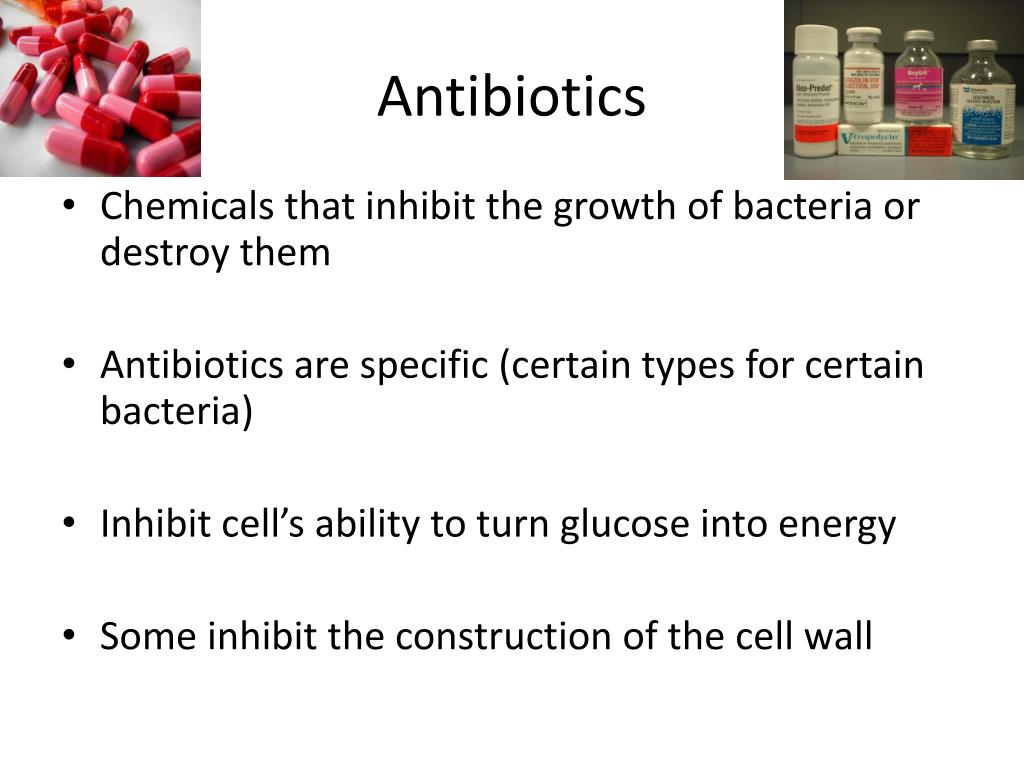
Length of treatment for cystitis can range from a single, one-time dose, to a course of medication over 5 to 7 days. Kidney infections may require injectable treatment, hospitalization, as well as a longer course of antibiotic, depending upon severity of the infection.
Sometimes a UTI can be self-limiting in women, meaning that the body can fight the infection without antibiotics; however, most uncomplicated UTI cases can be treated quickly with a short course of oral antibiotics. Never use an antibiotic that has been prescribed for someone else.
In men with symptoms that do not suggest a complicated UTI, treatment can be the same as women. In men with complicated UTIs and/or symptoms of prostatitis are not present, men can be treated for 7 days with a fluoroquinolone (ciprofloxacin, levofloxacin). Tailor therapy once urine cultures are available.
Are quinolones safe?
The fluoroquinolones, such as ciprofloxacin (Cipro) and levofloxacin (Levaquin) have also been commonly used for simple UTIs; however, FDA safety recommendations strongly suggest that this class be reserved for more serious infections and only be used if other appropriate antibiotics are not an option.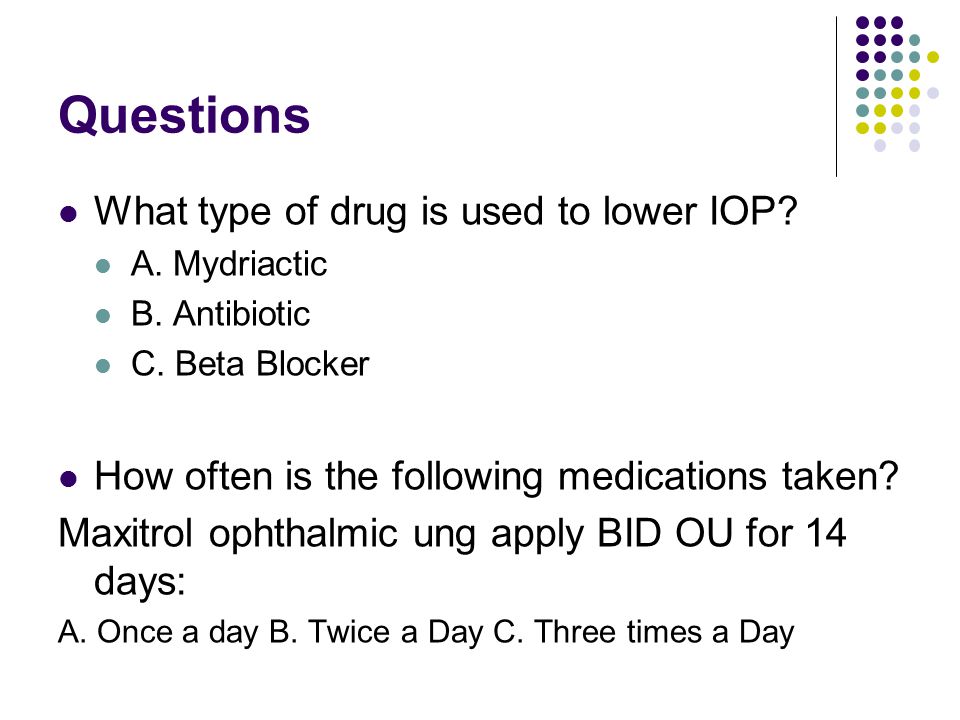
- An FDA safety review found that both oral and injectable fluoroquinolones (also called “quinolones”) are associated with serious and potentially disabling side effects involving tendons, muscles, joints, nerves and the central nervous system.
- These adverse effects can occur soon after administration to weeks after exposure, and may potentially be permanent.
- Patients should discuss the use of fluoroquinolones and their side effects with their healthcare provider.
However, certain oral fluoroquinolones may be appropriate for more complicated UTIs, including pyelonephritis and complicated UTIs in men with prostate involvement. For the outpatient treatment of uncomplicated pyelonephritis, the following quinolones may be appropriate. Based on resistance patterns (>10%), an inital dose of a long-acting parenteral antimicrobial, such as ceftriaxone, may be needed, or a 24-hour dose of an aminoglycoside.
Patients should be informed of the most current FDA warnings surrounding the use of fluoroquinolone antibiotics.
Will I need an intravenous (IV) antibiotic for a UTI?
If you are pregnant, have a high fever, or cannot keep food and fluids down, your doctor may admit you to the hospital so you can have treatment with intravenous (IV) antibiotics for a complicated UTI. You may return home and continue with oral antibiotics when your infection starts to improve.
In areas with fluoroquinolone resistance exceeding 10%, in patients with more severe pyelonephritis, those with a complicated UTI who have allergies to fluoroquinolones, or are unable to tolerate the drug class, intravenous therapy with an agent such as ceftriaxone, or an aminoglycoside, such as gentamicin or tobramycin, may be appropriate. Your ongoing treatment should be based on susceptibility data received from the laboratory.
Common side effects with antibiotic use
Each antibiotic is responsible for its own unique list of side effects, and the list is usually extensive. Be sure to discuss your individual antibiotic side effects with your healthcare provider. However, there are side effects that are common to most antibiotics, regardless of class or drug:
However, there are side effects that are common to most antibiotics, regardless of class or drug:
- Vaginal yeast infections or oral thrush (candida species): Antibiotics may also change the normal flora balance in the vagina and lead to a fungal overgrowth. Candida albicans is a common fungus normally present in small amounts in the vagina and does not usually cause disease or symptoms. However, vaginal candidiasis may occur when there is limited competition from bacteria due to antibiotic treatment.
- Abdominal (stomach) upset: Antibiotics are frequently linked with stomach upset such as nausea, vomiting, lack of appetite (anorexia), stomach pain, or heartburn (dyspepsia). Taking your antibiotic with a snack or a meal may help to decrease stomach upset, if you do not need to take it on an empty stomach. If your medication causes you to vomit, contact your doctor immediately for an alternative.
- Antibiotic-associated diarrhea: Antibiotics may commonly lead to uncomplicated antibiotic-associated diarrhea or loose stools, that will clear up after the antibiotic is stopped.
 Broad-spectrum antibiotics can also kill the normal gut flora (“good bacteria) and lead to an overgrowth of infectious bacteria, such as Clostridium difficile (C. difficile). If the diarrhea is severe, bloody, or is accompanied by stomach cramps or vomiting, a physician should be contacted to rule out C. difficile. The most common antibiotics implicated in antibiotic-associated diarrhea are amoxicillin-clavulanate, ampicillin, cephalosporins, fluoroquinolones, azithromycin, and clarithromycin.
Broad-spectrum antibiotics can also kill the normal gut flora (“good bacteria) and lead to an overgrowth of infectious bacteria, such as Clostridium difficile (C. difficile). If the diarrhea is severe, bloody, or is accompanied by stomach cramps or vomiting, a physician should be contacted to rule out C. difficile. The most common antibiotics implicated in antibiotic-associated diarrhea are amoxicillin-clavulanate, ampicillin, cephalosporins, fluoroquinolones, azithromycin, and clarithromycin.
- Stevens Johnson Syndrome (SJS), Toxic Epidermal Necrolysis (TEN): Stevens-Johnson syndrome (SJS) and toxic epidermal necrolysis (TEN) are rare but serious allergic drug reactions. Skin reactions like rash, skin peeling, and mucous membranes sores can occur and may be life-threatening. Antibiotics such as sulfonamides, penicillins, cephalosporins, and fluoroquinolones may result in SJS and TEN.
Related: Common Side Effects from Antibiotics, Allergies and Reactions
What about antibiotic resistance?
Resistance rates for antibiotics are always variable based on local patterns in the community and specific risk factors for patients, such as recent antibiotic use, hospital stay or travel. If you have taken an antibiotic in the last 3 months or traveled internationally, be sure to tell your doctor.
If you have taken an antibiotic in the last 3 months or traveled internationally, be sure to tell your doctor.
High rates of antibiotic resistance are being seen with both ampicillin and amoxicillin for cystitis (E. coli), although amoxicillin/clavulanate (Augmentin) may still be an option. Other oral treatments with reported increasing rates of resistance include sulfamethoxazole and trimethoprim (Bactrim DS, Septra DS) and the fluoroquinolones. Resistance rates for the oral cephalosporins and amoxicillin/clavulanate are still usually less than 10 percent.
Always finish taking your entire course of antibiotic unless your doctor tells you to stop. Keep taking your antibiotic even if you feel better and you think you don’t need your antibiotic anymore.
If you stop your treatment early, your infection may return quickly and you can develop resistance to the antibiotic you were using previously. Your antibiotic may not work as well the next time you use it.
Latest antibiotics for UTIs
The latest FDA antibiotic approvals for UTIs include:
Vabomere
- Vabomere (meropenem and vaborbactam) is a combination carbapenem antibiotic and beta-lactamase inhibitor.
 Vabomere was first approved in August of 2017.
Vabomere was first approved in August of 2017. - Vabomere is used for the treatment of adult patients with complicated urinary tract infections (including pyelonephritis) due to susceptible Escherichia coli, Klebsiella pneumoniae, Enterobacter cloacae species complex.
- Vabomere is given as an intravenous infusion every 8 hours. Dosage adjustments are required in patients with varying degrees of kidney impairment.
Zemdri
- Zemdri (plazomicin) is an aminoglycoside antibacterial for the treatment of complicated urinary tract infections, including pyelonephritis. Zemdri was first approved in February of 2015.
- Zemdri is used against certain Enterobacteriaceae in patients who have limited or no alternative treatment options. Zemdri is an intravenous infusion, administered once daily.
Avycaz
- Avycaz (ceftazidime and avibactam) is a cephalosporin and beta-lactamase inhibitor antibiotic combination used for complicated UTIs, including pyelonephritis, in adult and pediatric patients 3 months and older, and without alternative treatment options.
 Avycaz was first approved in February of 2015.
Avycaz was first approved in February of 2015. - Avycaz is used for complicated UTIs caused by the following susceptible Gram-negative microorganisms: Escherichia coli, Klebsiella pneumoniae, Enterobacter cloacae, Citrobacter freundiicomplex, Proteus mirabilis, and Pseudomonas aeruginosa.
- Avycaz is given as an intravenous infusion every 8 hours. Dosage adjustments are required in patients with varying degrees of kidney impairment.
Zerbaxa
- Zerbaxa (ceftolozane and tazobactam) is a cephalosporin and beta-lactamase inhibitor combination for the treatment of complicated urinary tract infections including pyelonephritis. Zerbaxa was first approved in December 2014.
- Zerbaxa is given as an intravenous infusion every 8 hours. Dosage adjustments are required in patients with varying degrees of kidney impairment.
See also: Treatment Options for UTIs
Are there any over-the-counter antibiotics for UTIs?
Over-the-counter (OTC) antibiotics for a UTI are not available. You should see your doctor to have your symptoms evaluated.
You should see your doctor to have your symptoms evaluated.
Your provider may recommend an OTC product called Uristat (phenazopyridine) to numb your bladder and urethra to ease the burning pain during urination. Uristat can be bought without a prescription at the pharmacy. A similar phenazopyridine product called Pyridium is also available.
Take phenazopyridine for only 48 hours, and be aware it may cause your urine to turn a brown, orange or red color which may stain fabrics or contact lenses. It may be best to not wear contact lenses while being treated with phenazopyridine.
Phenazopyridine is not an antibiotic and will not cure a UTI.
See also: Ratings of Urinary Anti-Infectives
What if I have frequent, recurring UTIs?
Within a year of havig a UTI infection, roughy one-quarter to one-half of women will have another UTI. For these women antibiotic prophylaxis (medication to help prevent a UTI) may be recommended by her health care provider.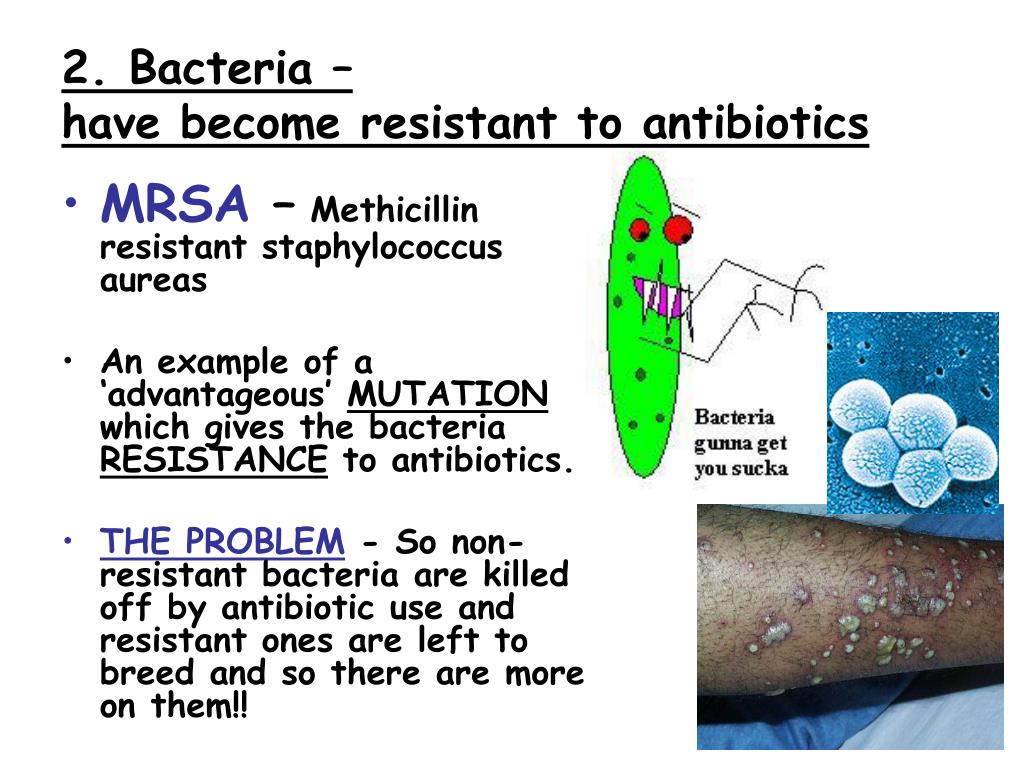 With a recurrent course of UTIs, a urine culture or imaging tests may be required for further analysis.
With a recurrent course of UTIs, a urine culture or imaging tests may be required for further analysis.
For recurrent UTIs, there are several antibiotic options for prevention:
- A shorter course (3 days) of antibiotics at the first sign of UTI symptoms; a prescription may be given to you to keep at home.
- A longer course of low-dose antibiotic therapy.
- Take a single dose of an antibiotic after sexual intercourse.
The choice of antibiotic is based on previous UTIs, effectiveness, and patient-specific factors such as allergies and cost. Antibiotics commonly used for recurrent UTIs can include sulfamethoxazole-trimethoprim, nitrofurantoin, cefaclor, or cephalexin.
In postmenopausal women with vaginal dryness that may be leading to recurrent UTIs, vaginal estrogen may be an effective treatment. Treatment options your doctor might recommend include: Estring(a vaginal ring), Vagifem (vaginal tablet insert), or vaginal estrogen creams (examples: Premarin, Vagifem, Yuvafem).
Can I treat a UTI without antibiotics?
UTI treatment without antibiotics is NOT usually recommended. An early UTI, such as a bladder infection (cystitis), can worsen over time, leading to a more severe kidney infection (pyelonephritis). However, a small study has suggested early, mild UTIs might clear up on their own. It’s always best to check with your doctor if you are having UTI symptoms.
Pregnant women should always see a doctor as soon as possible if they suspect they might have a UTI, as this can lead to a greater risk of delivering a low birth weight or premature infant.
Does cranberry juice prevent a UTI?
Some patients may want to use cranberry or cranberry juice as a home remedy to treat a UTI. Cranberry juice has not been shown to cure an ongoing bacterial infection in the bladder or kidney.
Cranberry has been studied as a preventive maintenance agent for UTIs. Studies are mixed on whether cranberry can really prevent a UTI.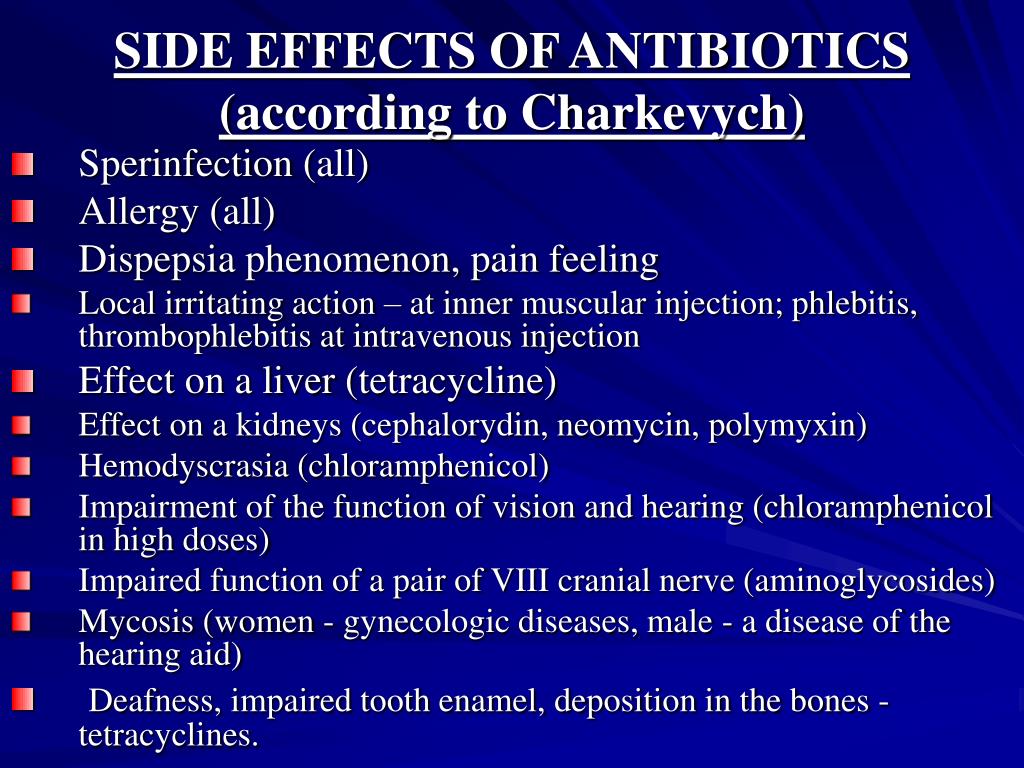 Cranberry may work by preventing bacteria from sticking to the inside of the bladder; however, it would take a large amount of cranberry juice to prevent bacterial adhesion. More recent research suggests cranberries may have no effect on preventing a UTI
Cranberry may work by preventing bacteria from sticking to the inside of the bladder; however, it would take a large amount of cranberry juice to prevent bacterial adhesion. More recent research suggests cranberries may have no effect on preventing a UTI
- According to one expert, the active ingredient in cranberries — A-type proanthocyanidins (PACs) — are effective against UTI-causing bacteria, but is only in highly concentrated cranberry capsules, not in cranberry juice.
- However, cranberry was not proven to prevent recurrent UTIs in several well-controlled studies, as seen in a 2012 meta-analysis of 24 trials published by the Cochrane group.
- While studies are not conclusive, there is no harm in drinking cranberry juice. However, if you develop symptoms, see your doctor. Some people find large quantities of cranberry juice upsetting to the stomach.
The effectiveness of many herbal or home remedies may not have been scientifically tested to the same degree as prescription medications — or at all. Over-the-counter herbal products and dietary supplements are not regulated by the FDA. Side effects and drug interactions may still occur with alternative treatments. Always check with your health care professional before using an over-the-counter, herbal or dietary supplement for any condition. In most cases, an antibiotic is the best treatment for a UTI.
Over-the-counter herbal products and dietary supplements are not regulated by the FDA. Side effects and drug interactions may still occur with alternative treatments. Always check with your health care professional before using an over-the-counter, herbal or dietary supplement for any condition. In most cases, an antibiotic is the best treatment for a UTI.
Increasing fluid intake like water, avoiding use of spermicides, and urinating after intercourse may be helpful in preventing UTIs, although limited data is available.
More Resources
Symptom Checker
See Also
Sources
- Jepson RG, Williams G, Craig JC. Cranberries for preventing urinary tract infections. Cochrane Database Syst Rev. 2012;10:CD001321. Accessed June 3, 2019 at https://www.ncbi.nlm.nih.gov/pubmed/23076891
- Lala V, Minter DA. Acute Cystitis. [Updated 2019 Mar 14]. In: StatPearls [Internet]. Treasure Island (FL): StatPearls Publishing; 2019 Jan-. Available from: https://www.
 ncbi.nlm.nih.gov/books/NBK459322/
ncbi.nlm.nih.gov/books/NBK459322/ - Hooton T, et al. Patient education: Urinary tract infections in adolescents and adults (Beyond the Basics). Oct 11, 2018. Accessed June 3, 2019 at https://www.uptodate.com/contents/urinary-tract-infections-in-adolescents-and-adults-beyond-the-basics
- Avycaz Product Label. Allergan. Accessed May 30, 2019 at https://www.allergan.com/assets/pdf/avycaz_pi
- Acute complicated urinary tract infection (including pyelonephritis) in adults. Up to Date. April 1, 2019. Accessed June 3, 2019 at https://www.uptodate.com/contents/acute-complicated-urinary-tract-infection-including-pyelonephritis-in-adults
- FDA Drug Safety Communication: FDA advises restricting fluoroquinolone antibiotic use for certain uncomplicated infections; warns about disabling side effects that can occur together. May 12, 2016. Accessed on June 4, 2019 at http://www.fda.gov/Drugs/DrugSafety/ucm500143.htm
Further information
Always consult your healthcare provider to ensure the information displayed on this page applies to your personal circumstances.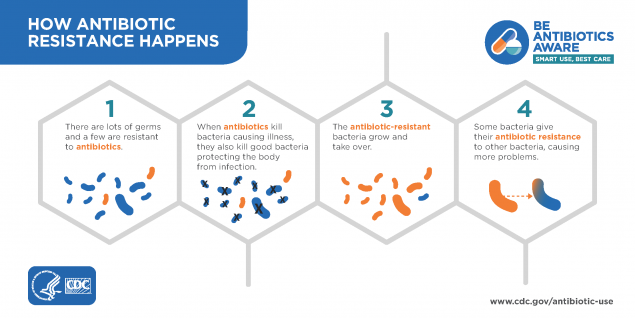
Medical Disclaimer
Antibiotics – Tests & treatments
Antibiotics are used to treat or prevent some types of bacterial infection. They work by killing bacteria or preventing them from reproducing and spreading.
Antibiotics aren’t effective against viral infections, such as the common cold, flu, most coughs and sore throats.
Many mild bacterial infections can also be cleared by your immune system without using antibiotics, so they aren’t routinely prescribed.
It’s important that antibiotics are prescribed and taken correctly to help prevent the progression of antibiotic resistance. This is when a strain of bacteria no longer responds to treatment with one or more types of antibiotics.
When antibiotics are used
Antibiotics may be used to treat bacterial infections that:
- are unlikely to clear up without antibiotics
- could infect others unless treated
- could take too long to clear without treatment
- carry a risk of more serious complications
People at a high risk of infection may also be given antibiotics as a precaution, known as antibiotic prophylaxis.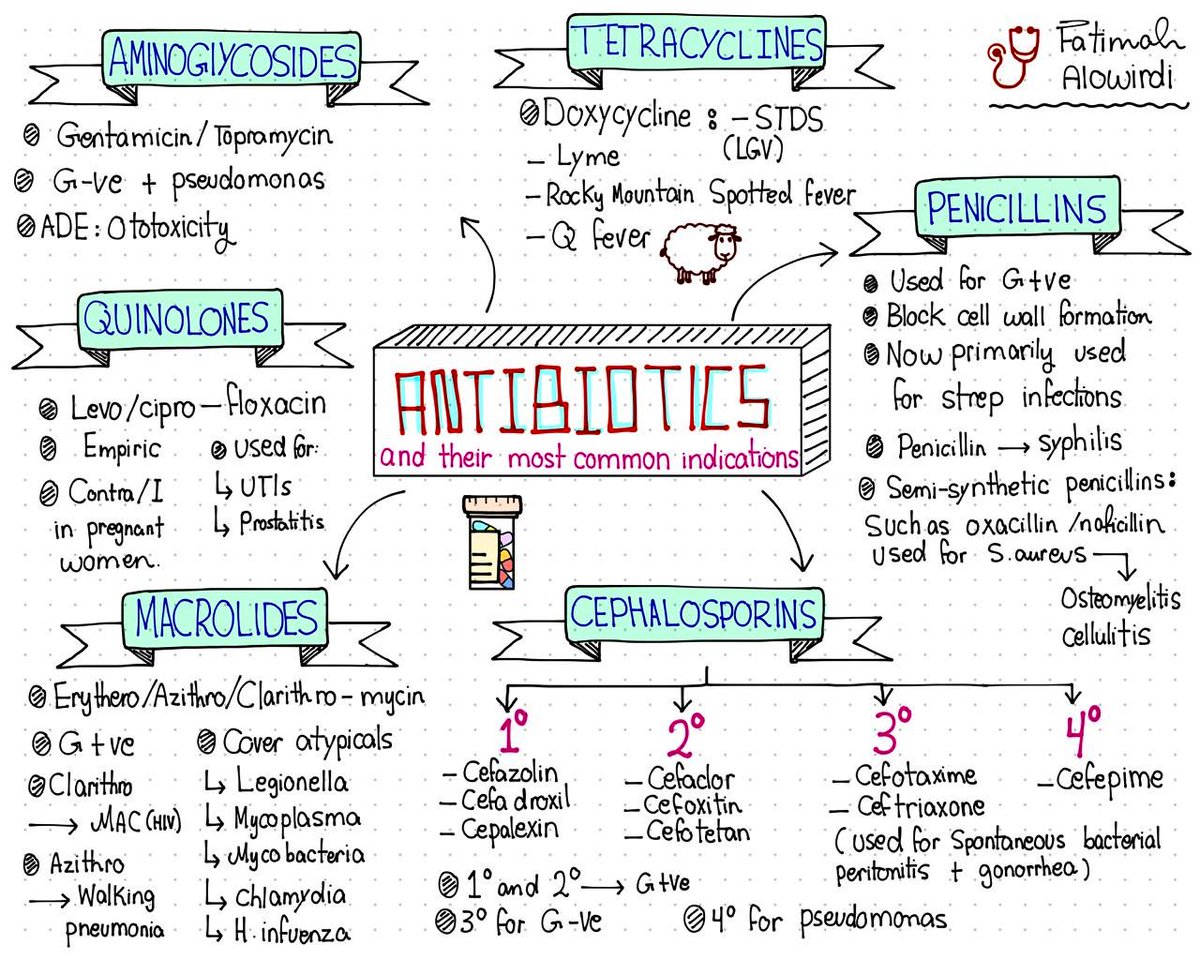
Read more about when antibiotics are used.
How do I take antibiotics?
Take antibiotics as directed on the packet or the patient information leaflet that comes with the medication, or as instructed by your GP or pharmacist.
Doses of antibiotics can be provided in several ways:
- oral antibiotics – tablets, capsules or a liquid that you drink, which can be used to treat most types of mild to moderate infections in the body
- topical antibiotics – creams, lotions, sprays or drops, which are often used to treat skin infections
- injections of antibiotics – these can be given as an injection or infusion through a drip directly into the blood or muscle, and are usually reserved for more serious infections
It’s essential to finish taking a prescribed course of antibiotics, even if you feel better, unless a healthcare professional tells you otherwise. If you stop taking an antibiotic part way through a course, the bacteria can become resistant to the antibiotic.
Missing a dose of antibiotics
If you forget to take a dose of your antibiotics, take that dose as soon as you remember and then continue to take your course of antibiotics as normal.
But if it’s almost time for the next dose, skip the missed dose and continue your regular dosing schedule. Don’t take a double dose to make up for a missed one.
There’s an increased risk of side effects if you take 2 doses closer together than recommended.
Accidentally taking an extra dose
Accidentally taking one extra dose of your antibiotic is unlikely to cause you any serious harm.
But it will increase your chances of experiencing side effects, such as pain in your stomach, diarrhoea, and feeling or being sick.
If you accidentally take more than one extra dose of your antibiotic, are worried or experiencing severe side effects, speak to your GP or call NHS 24 111 service as soon as possible.
Side effects of antibiotics
As with any medication, antibiotics can cause side effects. Most antibiotics don’t cause problems if they’re used properly and serious side effects are rare.
Most antibiotics don’t cause problems if they’re used properly and serious side effects are rare.
The most common side effects include:
- being sick
- feeling sick
- bloating and indigestion
- diarrhoea
Some people may have an allergic reaction to antibiotics, especially penicillin and a type called cephalosporins. In very rare cases, this can lead to a serious allergic reaction (anaphylaxis), which is a medical emergency.
Read more about the side effects of antibiotics.
Considerations and interactions
Some antibiotics aren’t suitable for people with certain medical conditions, or women who are pregnant or breastfeeding. You should only ever take antibiotics prescribed for you – never “borrow” them from a friend or family member.
Some antibiotics can also react unpredictably with other medications, such as the oral contraceptive pill and alcohol. It’s important to read the information leaflet that comes with your medication carefully and discuss any concerns with your pharmacist or GP.
Read more about how antibiotics interact with other medicines
Types of antibiotics
There are hundreds of different types of antibiotics, but most of them can be broadly classified into six groups. These are outlined below.
- penicillins (such as penicillin and amoxicillin) – widely used to treat a variety of infections, including skin infections, chest infections and urinary tract infections
- cephalosporins (such as cephalexin) – used to treat a wide range of infections, but some are also effective for treating more serious infections, such as septicaemia and meningitis
- aminoglycosides (such as gentamicin and tobramycin) – tend to only be used in hospital to treat very serious illnesses such as septicaemia, as they can cause serious side effects, including hearing loss and kidney damage; they’re usually given by injection, but may be given as drops for some ear or eye infections
- tetracyclines (such as tetracycline and doxycycline)– can be used to treat a wide range of infections, but are commonly used to treat moderate to severe acne and rosacea
- macrolides (such as erythromycin and clarithromycin) – can be particularly useful for treating lung and chest infections, or an alternative for people with a penicillin allergy, or to treat penicillin-resistant strains of bacteria
- fluoroquinolones (such as ciprofloxacin and levofloxacin) – broad-spectrum antibiotics that can be used to treat a wide range of infections
Antibiotic resistance
Both the NHS and health organisations across the world are trying to reduce the use of antibiotics, especially for conditions that aren’t serious.
The overuse of antibiotics in recent years means they’re becoming less effective and has led to the emergence of “superbugs”. These are strains of bacteria that have developed resistance to many different types of antibiotics, including:
These types of infections can be serious and challenging to treat, and are becoming an increasing cause of disability and death across the world.
The biggest worry is that new strains of bacteria may emerge that can’t be effectively treated by any existing antibiotics.
What They Are, How to Take Them, Side Effects
Antibiotics are medicines that help stop infections caused by bacteria. They do this by killing the bacteria or by keeping them from copying themselves or reproducing.
The word antibiotic means “against life.” Any drug that kills germs in your body is technically an antibiotic. But most people use the term when they’re talking about medicine that is meant to kill bacteria.
Before scientists first discovered antibiotics in the 1920s, many people died from minor bacterial infections, like strep throat. Surgery was riskier, too. But after antibiotics became available in the 1940s, life expectancy increased, surgeries got safer, and people could survive what used to be deadly infections.
Surgery was riskier, too. But after antibiotics became available in the 1940s, life expectancy increased, surgeries got safer, and people could survive what used to be deadly infections.
What Antibiotics Can and Can’t Do
Most bacteria that live in your body are harmless. Some are even helpful. Still, bacteria can infect almost any organ. Fortunately, antibiotics can usually help.
These are the types of infections that can be treated with antibiotics:
Only bacterial infections can be killed with antibiotics. The common cold, flu, most coughs, some bronchitis infections, most sore throats, and the stomach flu are all caused by viruses. Antibiotics won’t work to treat them. Your doctor will tell you either to wait these illnesses out or prescribe antiviral drugs to help you get rid of them.
It’s not always obvious whether an infection is viral or bacterial. Sometimes your doctor will do tests before deciding which treatment you need.
Some antibiotics work on many different kinds of bacteria.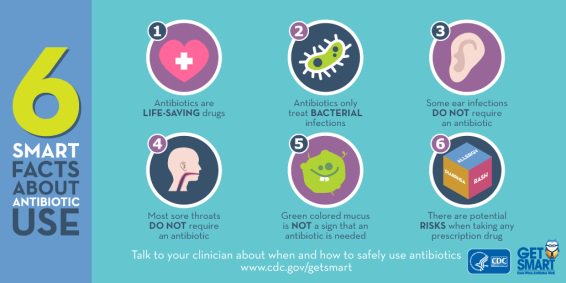 They’re called “broad-spectrum.” Others target specific bacteria only. They’re known as “narrow-spectrum.”
They’re called “broad-spectrum.” Others target specific bacteria only. They’re known as “narrow-spectrum.”
Side Effects
Since your gut is full of bacteria — both good and bad — antibiotics often affect your digestive system while they’re treating an infection. Common side effects include:
Occasionally, you may have other symptoms, like:
These symptoms can mean you’re allergic to your antibiotic, so let your doctor know right away if you have them.
If you’re taking birth control pills, antibiotics may keep them from working as well as they should, so speak to your doctor about whether alternative birth control methods might be a good idea. Women can also get vaginal yeast infections while taking antibiotics. The symptoms include itching, burning, vaginal discharge (looks similar to cottage cheese) and pain during sex. It’s treated with an anti-fungal cream.
Antibiotic Resistance
Antibiotics are a powerful germ-fighting tool when used carefully and safely.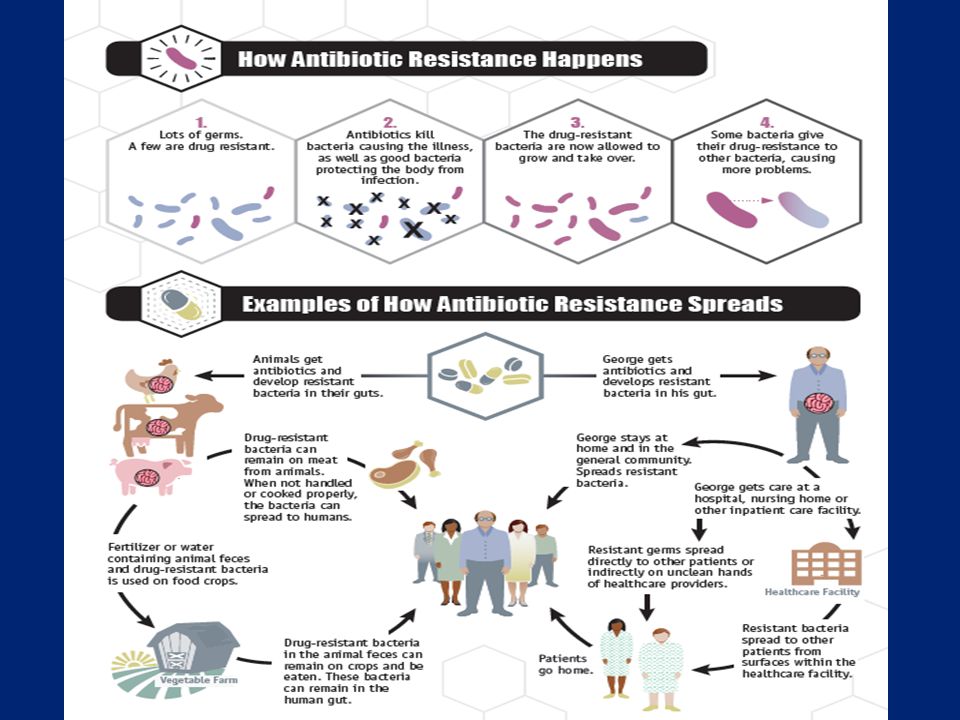 But up to one-half of all antibiotic use isn’t necessary. Overuse has led to antibacterial resistance. Bacteria adapt over time and become “super bacteria” or “superbugs.” They change so that antibiotics no longer work on them. They pose a big threat, because there aren’t any medicines to kill them.
But up to one-half of all antibiotic use isn’t necessary. Overuse has led to antibacterial resistance. Bacteria adapt over time and become “super bacteria” or “superbugs.” They change so that antibiotics no longer work on them. They pose a big threat, because there aren’t any medicines to kill them.
The best way to help slow the spread of super bacteria is by being smart with antibiotics. Here’s how:
- Trust your doctor if they say you don’t need them.
- Don’t take them for a viral infection.
- Only take the ones your doctor has prescribed for you.
- Take them as directed.
- Don’t skip doses.
- Take them for the full number of days your doctor prescribes.
- Don’t save them for later.
different types available in the UK
WLADIMIR BULGAR/SCIENCE PHOTO LIBRARYGetty Images
Have you been given a prescription for an antibiotic?
Our resident pharmacist Rita Ghelani offers advice on the different types of antibiotics available, how to take them and possible side effects.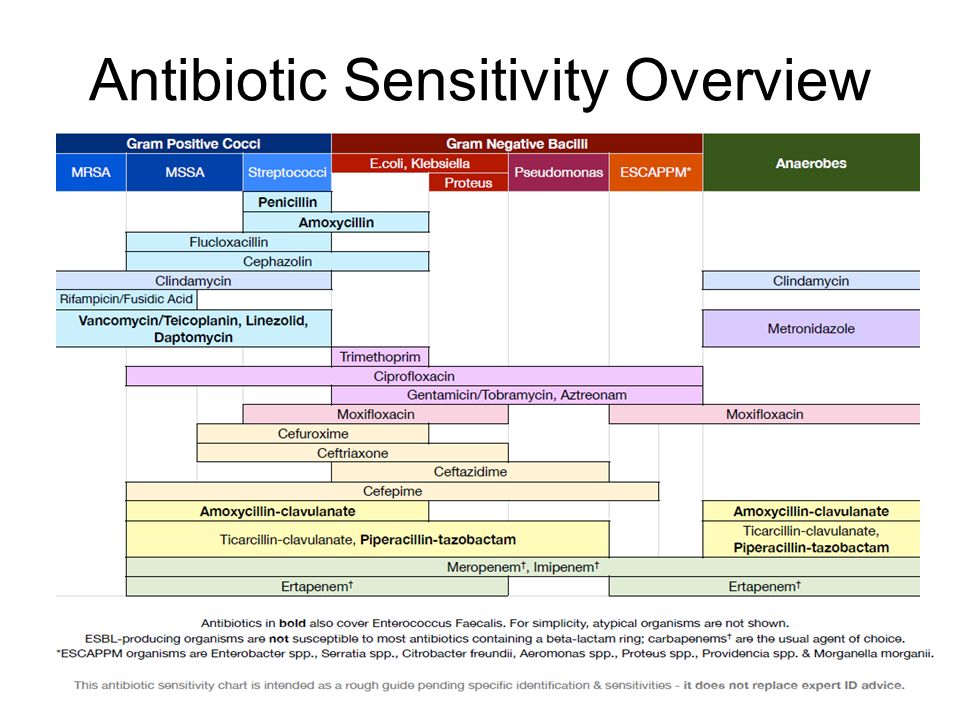
Different types of antibiotics
Infections that are caused by bacteria are treated with antibiotics. There are several different types of antibiotic available and your doctor needs to take into account various different factors when choosing which one to prescribe to treat an infection. These include where the infection is in the body and the type of bacteria causing it. Some antibiotics are better at treating certain types of infection than others. To make sure that you get the right treatment, your doctor may take a sample to identify the type of bacteria causing the infection, for example a swab from the throat or a urine sample.
Antibiotics do not work for infections caused by other types of micro-organism, such as viruses or fungi. Using them unnecessarily increases the risk of bacteria developing resistance to antibiotics. Antibiotic resistance is a growing problem across the world.
This article covers some of the different types of antibiotics that are currently available. Don’t forget this is only a guide – talk to your doctor or pharmacist if you’ve any questions about treatment.
Don’t forget this is only a guide – talk to your doctor or pharmacist if you’ve any questions about treatment.
Penicillin antibiotics
Penicillin antibiotics are the most widely used group of antibiotics. They are mainly broad-spectrum antibiotics that can be used for a wide variety of infections, such as respiratory tract infections, skin infections and urinary tract infections. Flucloxacillin is reserved for treating bacteria that are resistant to other penicillins.
Cephalosporin antibiotics
Cephalosporins are a group of broad-spectrum antibiotics that are related to the penicillins and are commonly used to treat infections caused by a wide variety of bacteria, including more serious infections such as septicaemia, pneumonia, meningitis, biliary-tract infections, peritonitis, and urinary-tract infections.
Macrolide antibiotics
Macrolide antibiotics have an antibacterial spectrum that is similar, but not identical, to that of penicillin, so are often used for people with a penicillin allergy or to treat penicillin-resistant strains of bacteria.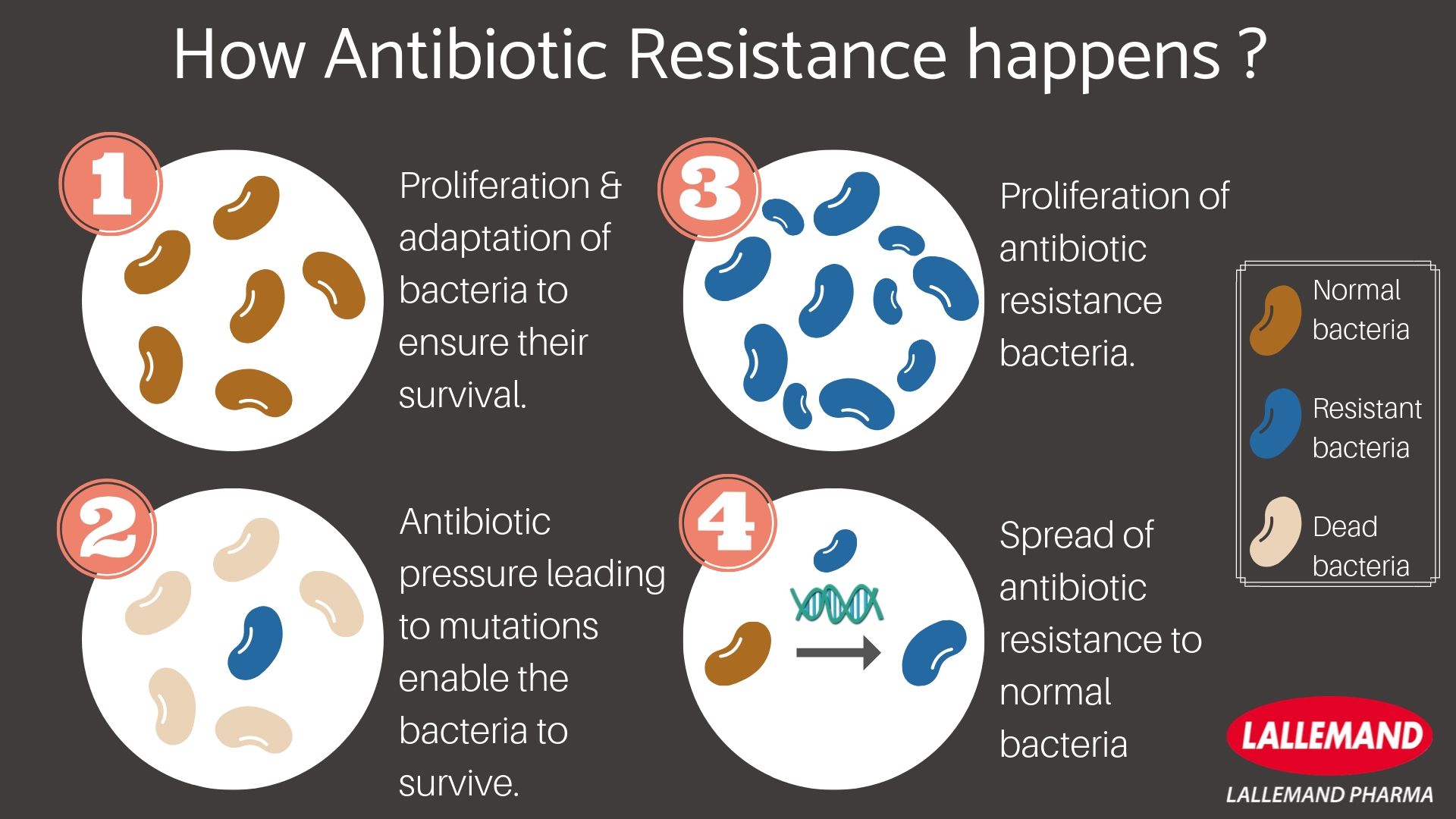 Macrolide antibiotics are particular useful for treating lung and chest infections. They are also used for skin infections and some sexually transmitted infections.
Macrolide antibiotics are particular useful for treating lung and chest infections. They are also used for skin infections and some sexually transmitted infections.
Quinolone antibiotics
These are broad-spectrum antibiotics that can be used to treat a wide range of infections, particularly urinary tract and chest infections.
Tetracycline antibiotics
Tetracycline antibiotics such as lymecycline and oxytetracycline are commonly used to treat moderate to severe acne and rosacea, but can also be used to treat a wide range of other bacterial infections, including respiratory and genital infections.
Aminoglycoside antibiotics
Aminoglycoside antibiotics work by inhibiting bacterial protein synthesis. They are not well absorbed when given by mouth so are often given by injection, but may also be given as drops for some ear or eye infections. These antibiotics are only used when other antibiotics are not suitable or have not been effective, because they can sometimes cause problems with the kidneys or with hearing.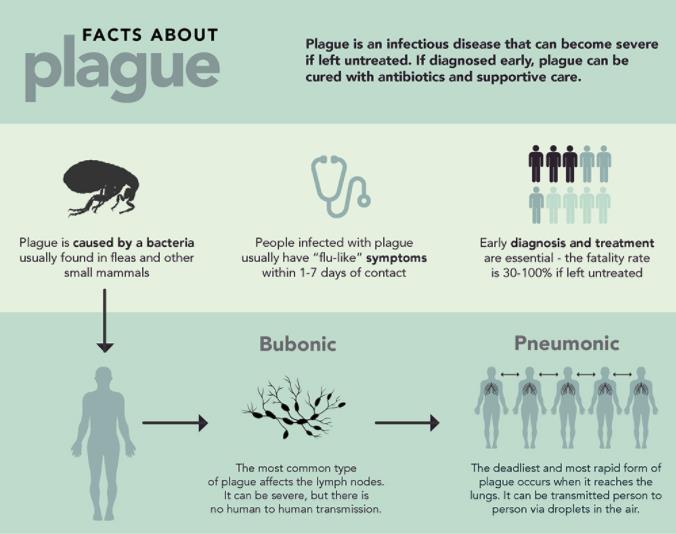
Sulphonamide antibiotics
The use of sulphonamides has decreased due to an increase in bacterial resistance and the development of other antibiotics that are more effective.
- Septrin (co-trimoxazole)
- Sulfadiazine
Other antibiotics
There are several other antibiotics that don’t fit into the groups above. These are used for more specific types of infections.
Last updated 28.10.2019
This content is created and maintained by a third party, and imported onto this page to help users provide their email addresses. You may be able to find more information about this and similar content at piano.io
Antibiotics | DermNet NZ
Author: Vanessa Ngan, Staff Writer. 2005.
What are antibiotics?
Antibiotics are chemical compounds used to kill or inhibit the growth of bacteria. Strictly speaking, antibiotics are a subgroup of organic anti-infective agents that are derived from bacteria or moulds that are toxic to other bacteria. However, the term antibiotic is now used loosely to include anti-infectives produced from synthetic and semisynthetic compounds.
However, the term antibiotic is now used loosely to include anti-infectives produced from synthetic and semisynthetic compounds.
The term antibiotic may be used interchangeably with the term antibacterial. However, it is incorrect to use the term antibiotic when referring to antiviral, antiprotozoal and antifungal agents.
History of antibiotics
Penicillin was the first antibiotic used successfully in treating bacterial infections. Sir Alexander Fleming first discovered it in 1928, but its potential for treatment against infections wasn’t recognised until over a decade later when Ernst B Chain, Sir Howard Florey and Norman Heatley produced enough purified penicillin to treat patients with. By the 1950s, a large number of antibiotics were being discovered and manufactured for the treatment of diseases caused by infecting bacteria. Over the last 50 years, antibiotics have transformed the patterns of disease and death.
Classification of antibiotics
Antibiotics can be classified in several ways. The most common method classifies them according to their chemical structure as antibiotics sharing the same or similar chemical structure will generally show similar patterns of antibacterial activity, effectiveness, toxicity and allergic potential.
The most common method classifies them according to their chemical structure as antibiotics sharing the same or similar chemical structure will generally show similar patterns of antibacterial activity, effectiveness, toxicity and allergic potential.
B-lactam antibiotics inhibit bacterial cell wall synthesis. They include:
Penicillins
- Penicillin G
- Amoxicillin
- Flucloxacillin
Cephalosporins
- Cefoxitin
- Cefotaxime
- Ceftriaxone
Carbapenem
Macrolides inhibit bacterial protein synthesis.
Tetracyclines inhibit bacterial protein synthesis.
- Tetracycline
- Minocycline
- Doxycycline
- Lymecycline
Fluoroquinolones inhibit bacterial DNA synthesis.
- Norfloxacin
- Ciprofloxacin
- Enoxacin
- Ofloxacin
Sulphonamides block bacterial cell metabolism by inhibiting enzymes.
- Trimethoprim + sulphamethoxazole
Aminoglycosides inhibit bacterial protein synthesis.
Imidazole antibiotics inhibit bacterial DNA synthesis.
Peptides inhibit bacterial cell wall synthesis.
Lincosamides inhibit bacterial protein synthesis.
The following drugs inhibit bacterial protein synthesis.
Uses of antibiotics
Antibiotics only work against infections caused by bacteria. Bacterial infections are much less common than viral infections. Most coughs and colds are of viral origin so antibiotics should not be prescribed for these. Antibiotics should only used when absolutely necessary, because:
- There is increasing resistance of bacteria to treatment
- Resistant bacteria are selected out by the use of antibiotics
- Antibiotics may have serious adverse effects in some people
Some common bacterial infections that do require antibiotic therapy include:
If these infections remain untreated, the resulting disease may be serious and even fatal.
In severe bacterial infections where patients may be hospitalized, often an intravenous broad-spectrum antibiotic (one that is active against many different bacteria) is given to start treatment.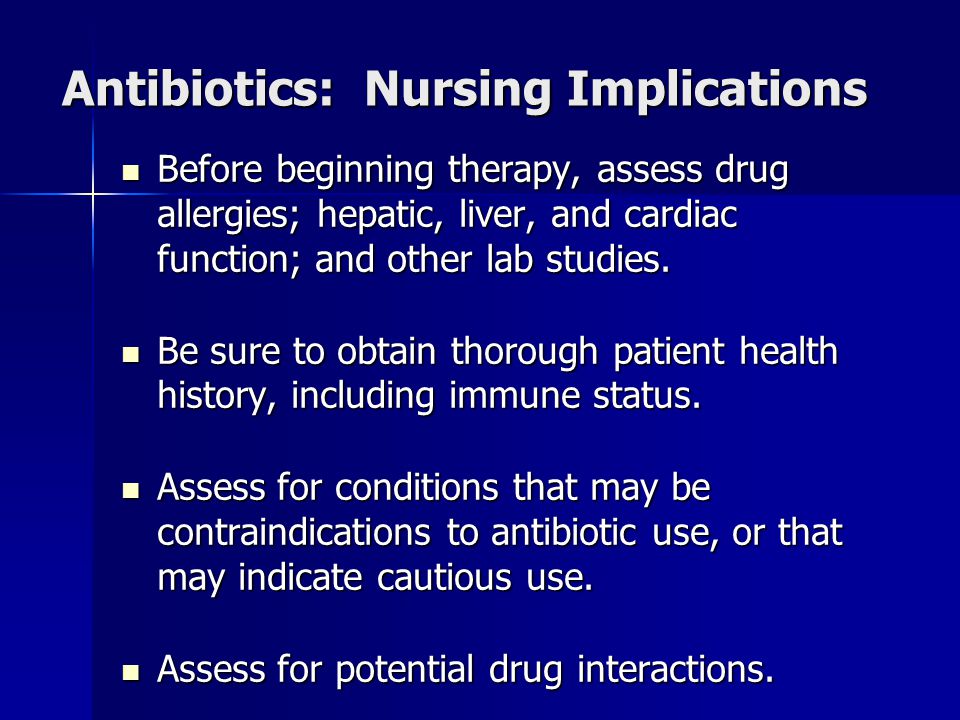 As soon as laboratory tests confirm the infecting bacteria, the antibiotic should be changed to one that is active against specific bacteria. After 48 hours of intravenous treatment, if there is clinical improvement, the patient may be switched to an oral form of the antibiotic.
As soon as laboratory tests confirm the infecting bacteria, the antibiotic should be changed to one that is active against specific bacteria. After 48 hours of intravenous treatment, if there is clinical improvement, the patient may be switched to an oral form of the antibiotic.
Antibiotic resistance
The overuse and inappropriate use of antibiotics has led to antibiotic resistance. Bacteria that were once susceptible to antibiotics have developed ways to survive the drugs that were meant to kill or weaken them. This is also known as antibacterial resistance or drug resistance. Some diseases such as tuberculosis, gonorrhoea and childhood bacterial ear infections, that were once easily treated with antibiotics are now again becoming difficult to treat as bacteria have become resistant to these drugs. About 70% of bacteria that cause infections in hospitals are resistant to at least one of the antibiotics most commonly used to treat infections. Methicillin (meticillin) resistant Staphylococcus aureus (MRSA) is a particular problem for patients with skin diseases, ulcers and surgical wounds.
Doctor responsibility
- Only prescribe antibiotics if bacterial infection present
- Prescribe the approved dose and duration or as recommended by experts
- Educate patient about the importance of completing their course of antibiotics as instructed
Patient responsibility
- Understand that not all infections are bacterial and that not all bacterial infections will clear on antibiotics (eg, folliculitis)
- Take antibiotics exactly as instructed (ie, with or without food etc)
- Ensure you finish the course of antibiotics
Side effects of antibiotics
Antibiotics are associated with many side effects, including cutaneous adverse reactions. Some side effects are class-related but most reactions are specific to the agent in that individual.
Some common problems with antibiotics are listed below:
- Allergy to certain antibiotics or classes of antibiotics (eg, penicillin allergy)
- Many antibiotics cause gastrointestinal problems (eg, diarrhoea, vomiting, nausea)
- Antibiotics kill not only their targets but other useful micro-organisms that live in and on our body (flora) to prevent other diseases (eg, oral and/or vaginal thrush)
- A variety of skin rashes can occur, which may be mild (eg, hives) or devastating (eg, toxic epidermal necrolysis).

New Zealand approved datasheets are the official source of information for these prescription medicines, including approved uses and risk information. Check the individual New Zealand datasheet on the Medsafe website.
The Danger of Antibiotic Overuse (for Parents)
What Is Antibiotic Overuse?
Antibiotic overuse is when antibiotics are used when they’re not needed. Antibiotics are one of the great advances in medicine. But overprescribing them has led to resistant bacteria (bacteria that are harder to treat).
Some germs that were once very responsive to antibiotics have become more and more resistant. This can cause more serious infections, such as pneumococcal infections (pneumonia, ear infections, sinus infections, and meningitis), skin infections, and tuberculosis.
What Do Antibiotics Treat?
Two major types of germs can make people sick: bacteria and viruses. They can cause diseases with similar symptoms, but they multiply and spread illness differently:
They can cause diseases with similar symptoms, but they multiply and spread illness differently:
Why Are Antibiotics Overprescribed?
Doctors prescribe antibiotics for different reasons. Sometimes they prescribe them when they’re not sure if an illness is caused by bacteria or a virus or are waiting for test results. So, some patients might expect a prescription for an antibitoic and even ask their doctor for it.
For example, strep throat is a bacterial infection, but most sore throats are due to viruses, allergies, or other things that antibiotics cannot treat. But many people with a sore throat will go to a health care provider expecting — and getting — a prescription for antibiotics that they do not need.
What Happens When Antibiotics Are Overused?
Taking antibiotics for colds and other viral illnesses doesn’t work — and it can create bacteria that are harder to kill.
Taking antibiotics too often or for the wrong reasons can change bacteria so much that antibiotics don’t work against them. This is called bacterial resistance or antibiotic resistance. Some bacteria are now resistant to even the most powerful antibiotics available.
This is called bacterial resistance or antibiotic resistance. Some bacteria are now resistant to even the most powerful antibiotics available.
Antibiotic resistance is a growing problem. The Centers for Disease Control and Prevention (CDC) calls it “one of the world’s most pressing public health problems.” It’s especially a concern in low-income and developing countries. That’s because:
- Health care providers there often lack quick, helpful diagnostic tools that can identify which illnesses are caused by bacteria and which are not.
- Many of the areas only recently got widespread access to antibiotics.
- Lack of clean water, poor sanitation, and limited vaccine programs contribute to the infections and illnesses that antibiotics are prescribed for.
What Can Parents Do?
Every family faces its share of colds, sore throats, and viruses. When you bring your child to the doctor for these illnesses, it’s important to not expect a prescription for antibiotics.
To lower the risk of bacterial resistance and prevent antibiotic overuse:
- Ask your doctor if your child’s illness is bacterial or viral. Discuss the risks and benefits of antibiotics. If it’s a virus, ask about ways to treat symptoms. Don’t pressure your doctor to prescribe antibiotics.
- Let milder illnesses (especially those caused by viruses) run their course. This helps prevent germs from becoming antibiotic-resistant.
- Antibiotics must be taken for the full amount of time prescribed by the doctor. Otherwise, the infection may come back.
- Don’t let your child take antibiotics longer than prescribed.
- Do not use leftover antibiotics or save extra antibiotics “for next time.”
- Don’t give your child antibiotics that were prescribed for another family member or adult.
It’s also important to make sure that your kids:
How do antibiotics work and why do we need them?
Antibiotics are arguably one of the most important and impactful medical discoveries—they’ve revolutionized how we treat illness and saved countless lives from bacterial infection.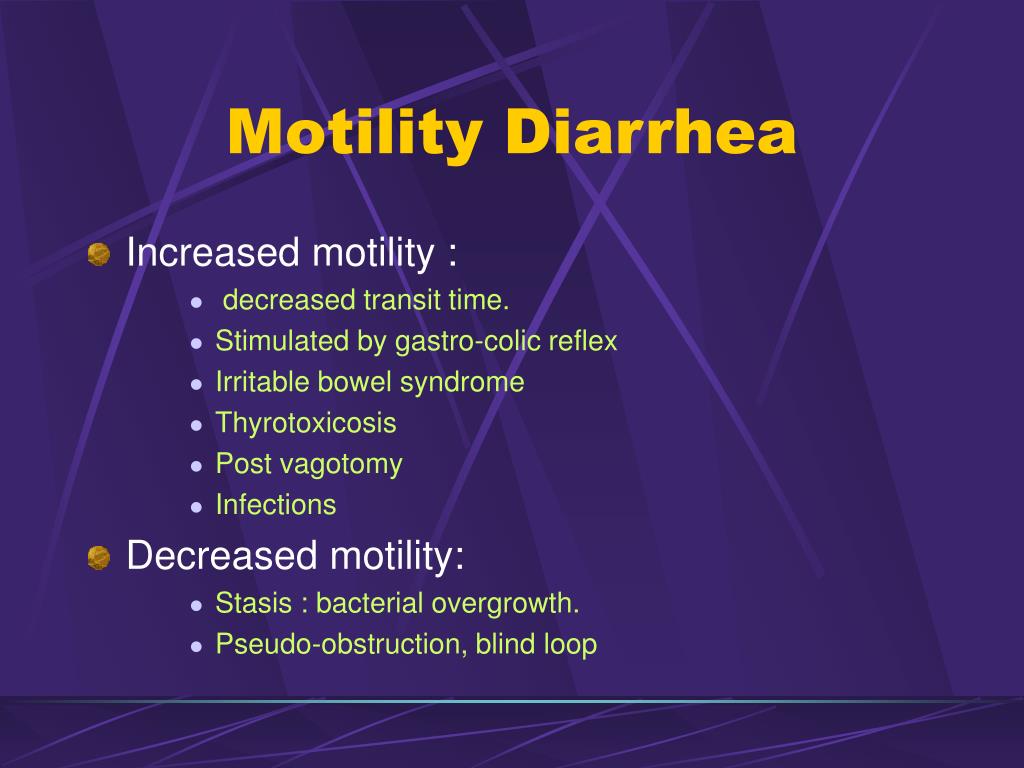
When were antibiotics invented?
In 1928, scientist Alexander Fleming accidentally discovered penicillin when he left a bacterial culture uncovered while away on vacation, according to Microbiology Society. A mold grew in his petri dishes, and killed the bacteria he was studying.
Fleming’s forgetfulness led to the first mass-produced antibiotic, or bacteria-killer, for which he won a Nobel Prize in Physiology or Medicine, along with two other scientists, in 1945.
What are antibiotics used to treat?
Antibiotics are life-saving medications prescribed to fight infections by killing bacteria or keeping it from reproducing, explains The National Library of Medicine’s MedlinePlus. While antibiotics are used to treat many serious bacterial infections, they are not required for—or effective on—viral infections, like the common cold or flu.
“Antibiotics are medications that are used to assist a patient’s immune system to combat bacterial infections,” Katie Taylor, Pharm. D., says. She adds that types of bacterial infections may include urinary tract infections, pneumonia, and skin and soft tissue infections, just to name a few.
D., says. She adds that types of bacterial infections may include urinary tract infections, pneumonia, and skin and soft tissue infections, just to name a few.
How do antibiotics work?
Antibiotics kill the bacterial cells causing your infection, but they leave human cells alone, explains The Genetic Science Learning Center at The University of Utah.
According to Merck Manual, there are a wide variety of antibiotics available, and each type of antibiotic works on certain kinds of bacteria. This is why your doctor prescribes specific antibiotics to treat particular bacterial infections. There are many types, or classes, of antibiotics: penicillins, tetracyclines, and nitrofurantoin, just to name a few.
Within these classes, there are a variety of brands available.
Different kinds of “antibiotics work in a variety of different ways depending on the class of antibiotic they are,” says Amesh Adalja, MD, a board-certified physician in infectious diseases and senior scholar at John Hopkins. “For example, penicillin and related antibiotics disrupt bacterial cell wall structure, while antibiotics like ciprofloxacin act on bacterial DNA processes.”
“For example, penicillin and related antibiotics disrupt bacterial cell wall structure, while antibiotics like ciprofloxacin act on bacterial DNA processes.”
There are also a variety of different forms of antibiotics. They can be taken orally, applied topically, or received as an injection. “One important factor to note is that not only does a particular antibiotic need to be able to kill a particular bacteria, but also get to the site of infection,” explains Dr. Taylor. “For example, not every antibiotic can get into the brain or into the bone, and if that is where the infection is, it will be difficult to treat that infection with that drug.” Your physician prescribes the form that can best target where the infection is in your body.
How long does it take antibiotics to work?
Antibiotics kick in fairly quickly, at least at the microbiological level, explains Dr. Adalja. “However, depending on the extent and severity of the infection, it may take hours or days for a person’s symptoms to noticeably change,” he adds.
When your symptoms start to improve, you shouldn’t stop taking your prescription. “It is important to stress that a patient should take the entire course of antibiotics prescribed by your healthcare provider to ensure adequate treatment of the infection so that it does not recur nor cause antibiotic resistance,” Dr. Taylor emphasizes.
RELATED: What happens if you don’t finish antibiotics?
How do bacteria become resistant to antibiotics?
Antibiotic resistance occurs when bacteria learn how to overcome the antibiotic that is supposed to kill them. It occurs when people overuse and underuse antibiotics. They take them for a condition that doesn’t require antibiotics, or they stop taking an antibiotic before the prescription ends. Both scenarios give bacteria the opportunity to mutate.
Antibiotic resistance is so common that the Centers for Disease Control and Prevention (CDC) consider it one of the most urgent public health crises. Every year more than 2 million people get an antibiotic-resistant infection, and at least 23,000 people die from it, according to the CDC. “Infections caused by antibiotic-resistant germs are difficult, and sometimes impossible, to treat. In most cases, antibiotic-resistant infections require extended hospital stays, additional follow-up doctor visits, and costly and toxic alternatives,” says the CDC site.
Dr. Adalja says that while overuse of antibiotics can lead to antibiotic resistance, the bacteria’s ability to evolve and resist the medication designed to kill it is also a fact of life and evolution. “Antibiotic resistance is caused by a variety of factors, but generally is due to bacteria being exposed to an antibiotic for some time, and the bacteria mutating (or figuring out) how to get around the drug’s mechanism of action,” agrees Dr. Taylor.
When to take antibiotics
The best way to prevent antibiotic resistance is to avoid taking antibiotics when you don’t need to—for example, don’t take antibiotics to treat viruses. Use preventative measures like vaccines and healthy hygiene habits to avoid getting sick. Then, if you do need them, make sure that you take your antibiotics exactly as prescribed.
90,000 types of drugs and admission rules
These drugs are used to treat diseases caused by a bacterial infection. In diseases of the ENT organs and bronchi, four main groups of antibiotics are used. These are penicillins, cephalosporins, macrolides and fluoroquinolones. They are convenient because they are available in tablets and capsules, that is, for oral administration, and they can be taken at home.
Each of the groups has its own characteristics, but for all antibiotics there are admission rules that must be followed.
Antibiotics should be prescribed only by a doctor for certain indications. The choice of antibiotic depends on the nature and severity of the disease, as well as on what drugs the patient received earlier.
Antibiotics should not be used to treat viral diseases.
The effectiveness of the antibiotic is assessed during the first three days of its administration. If the antibiotic works well, you should not interrupt the course of treatment before the time recommended by your doctor. If the antibiotic is ineffective (the symptoms of the disease remain the same, the fever persists), inform your doctor.Only the doctor decides on the replacement of the antimicrobial drug.
Side effects (eg, mild nausea, unpleasant taste in the mouth, dizziness) do not always require immediate discontinuation of the antibiotic. Often, only a dose adjustment of the drug or additional administration of drugs that reduce side effects is sufficient. The measures for overcoming the side effects are determined by the doctor.
Diarrhea may develop as a consequence of taking antibiotics. If you have heavy loose stools, see your doctor as soon as possible.Do not try to treat antibiotic-related diarrhea yourself.
Do not reduce the dose of the medicine prescribed by your doctor. Low doses of antibiotics can be dangerous because they are more likely to develop resistant bacteria after they are used.
Strictly observe the time of taking the antibiotic – the concentration of the drug in the blood must be maintained.
Some antibiotics must be taken before meals, others after. Otherwise, they are absorbed worse, so do not forget to check with your doctor about these features.
Cephalosporins
Features: broad spectrum antibiotics. They are mainly used intramuscularly and intravenously for pneumonia and many other serious infections in surgery, urology, gynecology. Of the drugs for oral administration, only cefixime is now widely used.
Important Patient Information:
- Causes allergies less frequently than penicillins. But a person who is allergic to the penicillin group of antibiotics can develop a so-called cross-allergic reaction to cephalosporins.
- Can be used by pregnant women and children (each drug has its own age restrictions). Some cephalosporins are approved from birth.
Most common side effects: allergic reactions, nausea, diarrhea.
Main contraindications: individual intolerance.
Penicillins
Main Readings:
- Angina
- Exacerbation of chronic tonsillitis
- Acute otitis media
- Sinusitis
- Exacerbation of chronic bronchitis
- Community-acquired pneumonia
- Scarlet fever
- Skin infections
- Acute cystitis, pyelonephritis and other infections
Features: are low-toxic broad-spectrum antibiotics.
Most common side effects: allergic reactions.
Main contraindications: individual intolerance.
Important Patient Information:
- Drugs in this group are more likely to cause allergies than other antibiotics. An allergic reaction to several drugs from this group is possible. If you develop a rash, hives, or other allergic reactions, stop taking the antibiotic and see your doctor as soon as possible.
- Penicillins are one of the few groups of antibiotics that can be used by pregnant women and children from a very young age.
- Preparations containing amoxicillin reduce the effectiveness of birth control pills.
Macrolides
Main Readings:
- Infection with mycoplasma and chlamydia (bronchitis, pneumonia in people over 5 years old)
- Angina
- Exacerbation of chronic tonsillitis
- Acute otitis media
- Sinusitis
- Exacerbation of chronic bronchitis
- Whooping cough
Features: antibiotics used mainly in the form of tablets and suspensions.They act a little slower than antibiotics of other groups. This is due to the fact that macrolides do not kill bacteria, but stop their reproduction. Relatively rarely cause allergies.
Most common side effects: allergic reactions, abdominal pain and discomfort, nausea, diarrhea.
Main contraindications: individual intolerance.
Important Patient Information:
- The resistance of microorganisms to macrolides is rapidly developing.Therefore, you should not repeat the course of treatment with drugs of this group for three months.
- Some of the drugs in this group can interfere with the activity of other drugs, and may be less absorbed when they interact with food. Therefore, before using macrolides, you must carefully study the instructions.
Fluoroquinolones
Main Readings:
- Severe otitis externa
- Sinusitis
- Exacerbation of chronic bronchitis
- Community-acquired pneumonia
- Dysentery
- Salmonellosis
- Cystitis, pyelonephritis
- Adnexitis
- Chlamydia and other infections
Features: powerful antibiotics, most often used for severe infections.They can disrupt the formation of cartilage, and therefore are contraindicated for children and expectant mothers.
Most common side effects: allergic reactions, pain in tendons, muscles and joints, abdominal pain and discomfort, nausea, diarrhea, drowsiness, dizziness, increased sensitivity to ultraviolet rays.
Main contraindications: individual intolerance, pregnancy, breastfeeding, age up to 18 years.
Important Patient Information:
- Oral fluoroquinolones should be taken with a full glass of water, and in total during the treatment period, drink at least 1.5 liters per day.
- For complete assimilation, you must take the drugs at least 2 hours before or 6 hours after taking antacids (remedies for heartburn), iron, zinc, bismuth preparations.
- It is important to avoid sunburn while using drugs and for at least 3 days after the end of treatment.
Remember, self-medication is life-threatening, consult your doctor for advice on the use of any medications.
Source: http: // www.aif.ru/health/
90,000 to whom, when and how to receive
When are they prescribed, is it worth fearing side effects and why may the result be unexpected? We tell you what doctors think about antibiotics.
Don’t repeat at home
An antibiotic is a potent medicine and should always be prescribed by a doctor. For more than two decades, many pharmacies have freely sold prescription drugs, other than narcotic and psychotropic drugs, in an effort to increase revenue.This led to the fact that many doctors have forgotten how to draw up prescription forms, writing out prescriptions on sheets of a notebook, without even putting a stamp. And the patients bought antibacterial drugs for self-treatment, they are also antimicrobial drugs. Control has tightened only in the last two years.
“Even before I started working at the Fantasy Children’s Clinic,” says pediatrician Victoria Alipova, “they brought a child to the appointment who complained of abdominal pain and abnormal stool.The history showed that the boy 12 times in the last year underwent antibiotic treatment for every cold, including ARVI, when such drugs are useless. The first time the antibiotic was prescribed by the doctor, and then the mother of the child acted by analogy. It was enough to cancel the drug, and the problem with the intestines would be normalized. Children can take antimicrobials in the form of syrups or suspensions even from birth, but only according to indications determined by the doctor. Many doctors prescribe such drugs for any reason. “
Antibiotics have many side effects. First of all, they destroy the intestinal microflora: diarrhea, vomiting appear, colitis, liver and kidney dysfunctions, allergies are possible. In such cases, probiotics or other drugs that normalize the functions of the gastrointestinal tract are often prescribed in parallel. However, urologist Rinaz Kamaletdinov says that clinical guidelines do not indicate that such drugs are able to stabilize the intestinal microflora against the background of antibiotic therapy.And in each case of the disease, only a specialist can make a decision about the type of therapy:
“Antibiotic treatment should be carried out by a doctor,” said Dr. Kamaletdinov. – Even if similar symptoms reappear, you should not take the pills left over from a past illness. A doctor can be consulted online or by phone. In urology, different types of antibiotics are used, most often fluoroquinolones, especially levofloxacin. Often it is necessary to change the pharmacological group, dose, duration and schedule of administration.For example, a patient with E. coli bacterial prostatitis received one type of antibiotic. Treatment requires 28 days, but symptoms returned by 3 weeks. It turned out that a second infection appeared in the body, and E. coli developed resistance to the drug. I had to additionally prescribe a drug of a different spectrum ”.
Is it possible to defeat resistance
Over time, the bacteria adapt, producing genes that protect against antibiotics.If a person becomes infected with such bacteria, it is much more difficult to treat him. This process is of a planetary scale, and in many respects the doctors themselves are to blame for the problem. They often recklessly use broad-spectrum antibiotics, which, like carpet bombing, destroy the microflora of the mucous membranes.
“It’s easier to prescribe an antibiotic to a child with a high fever or an unconscious resuscitation patient and not worry about further treatment,” complains therapist and medical blogger Philip Kuzmenko.“The doctor simplifies his work by firing ‘a cannon at the sparrows’, achieves the patient’s recovery, but at too high a price.”
The next time the same illness overtakes the recovered person, the old medicine may not work because the bacteria have learned to resist it. In this arms race, microbes have clear advantages. There will always be bacteria against which even the latest generation drugs will be powerless.
“Self-medication with antibiotics is the murder of our grandchildren and great-grandchildren,” Dr. Kuzmenko is convinced.- Every day I receive letters stating that inexperienced or incompetent doctors prescribe antibiotics for ARVI. Mortality from influenza does not exceed 2-3%, and from a bacterial infection for which there is no cure, it reaches 50%. Personally, in the first year of practice, I often prescribed antibiotics, then less often, and almost never in the 4th or 5th year. There are 3 groups of so-called antibiotics of choice or first-line antibiotics: penicillins, macrolides, and cephalosporins. These drugs are prescribed in the event of a threatening situation even before an accurate diagnosis is confirmed.It is a myth that pneumonia can be “listened to” at an early stage, but in some cases the patient may not even get to the pharmacy. Therefore, empirically, from a variety of antibiotics, we have selected “broad spectrum” drugs acting on 20-25 species of bacteria ”.
When are antibiotics needed?
Antimicrobial drugs are indicated only in extreme cases of an acute course of the disease: with pneumonia, angina, acute pyelonephritis, purulent otitis media, meningococcal infection, and in the case of a very high temperature with suspected sepsis.With rhinitis, bronchitis, laryngitis and many other diseases, antibiotics should not be taken. However, Russian treatment protocols provide for such a possibility.
“It is much more effective to treat bacterial otitis media or sinusitis with intranasal steroids and rinsing the nose,” says Oleg Abramov, otolaryngologist at GMS Clinic. – Practice has shown that 80% of acute diseases do not require antibiotics. If, nevertheless, I prescribe them, then these are drugs of the penicillin group, ceftriaxone, clindamycin.But never right away. With bacterial rhinosinusitis, when a runny nose does not go away from the onset of a cold for more than 10 days, I try to solve the problems by other means for another 5 days. If this does not help, I prescribe an antibiotic. It is extremely important to observe the duration of admission here, since the disease is insidious. After the symptoms disappear, the drug must be taken for another 5 days. And for example, with pneumococcal infection, the standard dosage does not cope with the bacteria, and the dose of the antibiotic must be doubled. ”
For most diseases, antibiotic therapy does more harm than good.
“For 7 years of practice, I observed about 700 thousand people with colds and no more than 10 pneumonia,” says Philip Kuzmenko. – In one case, pneumonia was caused by a superbug, a microbe extremely resistant to most known antibiotics. We tried many drugs, but none of them worked, and the patient did not survive. ”
If there is a suspicion of a disease in which antibiotics are needed, doctors immediately begin antibiotic therapy, but they must make sure that the diagnosis is correct and, if necessary, adjust the treatment.Pneumonia can be confirmed by x-rays of the lungs; in other cases, blood or urine is usually taken for culture, determining which selective antibiotic the microbe is sensitive to. But, unlike X-rays, bacterial inoculation takes a significant amount of time. “Analysis of blood or urethral discharge in our clinic requires 3-5 days,” says Rinaz Kamaletdinov. “The most modern laboratories can do it in 1-2 days.”
According to Philip Kuzmenko, bacterial culture is relevant in a hospital setting, and on an outpatient basis it is neglected for many reasons.But Oleg Abramov believes that in accordance with Western treatment standards, bacterial culture has no proven diagnostic efficacy, and never prescribes it.
Some doctors do not take into account that any acute state of the disease is translated into chronic antibiotics. Immunity is suppressed by these drugs, without having time to develop the necessary antibodies that would avoid the subsequent chronic stage of the disease.
But doctors do not see the danger in getting unnecessary antibiotics with poultry or livestock.For the treatment of animals, they really use the same penicillin, tetracycline, chloramphenicol, but being digested, they lose their aggressive medicinal properties, and enter the human body already harmless.
- Antibiotics are needed in rare cases of exacerbation:
- pneumonia
- sore throats
- meningitis
- purulent otitis media
- acute pyelonephritis and cystitis
- cases of prolonged and very high temperature
- Antibiotics can only be taken as directed by a doctor who chooses a specific drug, dosage, duration and schedule of administration
- Antibiotics have many side effects
- Bacteria develop resistance to most antibiotics.The drug once worked may not work the next time
What natural antibiotics can be found in any kitchen
https://crimea.ria.ru/20210712/Kakie-prirodnye-antibiotiki-mozhno-nayti-na-lyuboy-kukhne-1119792932.html
What natural antibiotics can be found in any kitchen
What natural antibiotics can be found in any kitchen – RIA Novosti Crimea, 12.07.2021
What natural antibiotics can be found in any kitchen
In any kitchen you can find many products with an antibacterial effect.Food.news lists the best natural antibiotics. RIA Novosti Crimea, 12.07.2021
2021-07-12T21: 24
2021-07-12T21: 24
2021-07-12T19: 36
society
news
/ html / head / meta [@ name = ‘og: title’] / @ content
/ html / head / meta [@ name = ‘og: description’] / @ content
https://cdn1.img.crimea.ria.ru/img/ 111433/38 / 1114333854_0: 37: 765: 471_2072x0_60_0_0_48ba55aceaf7e078c6bd5a0ba7a4c7d7.jpg
SIMFEROPOL, July 12 – RIA Novosti Crimea.There are many antibacterial products to be found in any kitchen. Food.news lists the best natural antibiotics. Garlic Garlic contains a compound called allicin. It can be obtained by mechanical destruction of garlic cells. Allicin has antibacterial action against gram-positive and gram-negative bacteria. Garlic also kills Staphylococcus aureus, which can cause both mild skin infections and deadly diseases like pneumonia and meningitis.From the latter, allicin aerosol is effective.To obtain an antibacterial compound at home, you can grind fresh garlic to an oily state. As such, it can be added to salads and sauces. Honey In ancient Greece, honey was used as a remedy for the treatment of abrasions and wounds. And this is no coincidence, because honey creates a protective coating. Certain types of bee products, such as manuka honey, have powerful antimicrobial properties. The ability of honey to kill bacteria is associated with the content of hydrogen peroxide in it.Ginger Ginger is known for its antimicrobial activity against E. coli bacteria. Most strains of the bacillus are harmless, but there are some that cause severe digestive problems, stomach cramps, and diarrhea. Its antibiotic properties are attributed to numerous potent compounds such as borneol, camphene and linalool. Echinacea Echinacea is used to prevent colds and flu. In folk medicine, echination in various forms (tinctures, decoctions, etc.) is used to treat infections.Scientists have found that this plant can kill various bacteria, in particular streptococcus, which causes sore throats, toxic shock and necrotizing fasciitis. Clove: Dried clove buds are widely used in Indian medicine as a remedy for toothache. There are studies that confirm the effectiveness of cloves against E. coli. Oregano Oregano or oregano has antibacterial and antioxidant properties. For the prevention of diseases, it is better to use oregano essential oil: it contains carvacrol and thymol.How weeds can be good for your health & gt; & gt; How mushrooms help you avoid cancer & gt; & gt;
RIA Novosti Crimea
7 495 645-6601
FSUE MIA “Russia Today”
https: //xn--c1acbl2abdlkab1og.xn--p1ai/awards/21
20
RIA Novosti Crimea
7 495 645-6601
FSUE MIA Rossiya Segodnya
https: // xn – c1acbl2abdlkab1og.xn – p1ai / awards /
News
ru-RU
https://crimea.ria.ru/docs/about/copyright.html
https: //xn--c1acbl2abdlkab1og.xn--p1ai/
RIA Novosti Crimea
7 495 645-6601
Federal State Unitary Enterprise MIA Rossiya Segodnya
https: //xn--c1acbl2abdlkab1og.xn--p1ai/awards/
RI News Crimea
7 495 645-6601
FSUE MIA “Russia Today”
https: // xn – c1acbl2abdlkab1og.xn – p1ai / awards /
RIA Novosti Crimea
7 495 645-6601
FSUE MIA Rossiya Segodnya
https: //xn--c1acbl2abdlkab1og.xn-- p1ai / awards /
society, news
SIMFEROPOL, 12 July – RIA Novosti Crimea. There are many antibacterial products in every kitchen. Food.news lists the best natural antibiotics.
Garlic
Garlic contains an allicin compound.It can be obtained by mechanical destruction of garlic cells. Allicin has antibacterial action against gram-positive and gram-negative bacteria. Garlic also kills Staphylococcus aureus, which can cause both mild skin infections and deadly diseases like pneumonia and meningitis. From the latter, allicin aerosol is effective.
To obtain an antibacterial compound at home, you can grind fresh garlic to an oily state.As such, it can be added to salads and sauces.
Honey
In ancient Greece, honey was used as a remedy for the treatment of abrasions and wounds. And this is no coincidence, because honey creates a protective coating. Certain types of bee products, such as manuka honey, have powerful antimicrobial properties. The ability of honey to kill bacteria is associated with the content of hydrogen peroxide in it.
Ginger
Ginger is known for its antimicrobial activity against E. coli bacteria.Most strains of the bacillus are harmless, but there are some that cause severe digestive problems, stomach cramps, and diarrhea. Its antibiotic properties are attributed to numerous potent compounds such as borneol, camphene, and linalool.
Echinacea
Echination is used to prevent colds and flu. In folk medicine, echination in various forms (tinctures, decoctions, etc.) is used to treat infections. Scientists have found that this plant can kill various bacteria, in particular streptococcus, which causes sore throats, toxic shock and necrotizing fasciitis.
Clove
Dried clove buds are widely used in Indian medicine as a remedy for toothache. There are studies that confirm the effectiveness of cloves against E. coli.
Oregano
Oregano or oregano has antibacterial and antioxidant properties. For the prevention of diseases, it is better to use oregano essential oil: it contains carvacrol and thymol.
How weeds can be good for health >> How champignons help prevent cancer >> 90,027 90,000 Local antibiotics in people with chronic suppurative otitis media What is the purpose of this review? The aim of this Cochrane Review was to determine whether topical antibiotics are effective in treating chronic suppurative otitis media and whether one topical antibiotic treatment is more effective than others.To answer this question, we collected and analyzed all relevant studies. Key Information There is great uncertainty as to whether the use of topical antibiotics accelerates the resolution of ear discharge in patients with chronic suppurative otitis media (CCPM). However, despite this uncertainty, there is some evidence to suggest that the use of topical antibiotics may be effective when compared to placebo or when used in addition to a systemic antibiotic (oral or injectable).There is also a lot of uncertainty as to which type of topical antibiotic is most effective. Overall, the certainty of the evidence was very low. What was learned in this review? Chronic suppurative otitis media (CHS) is a prolonged (chronic) edema and infection of the middle ear, with discharge from the ear (otorrhea) through the perforated tympanic membrane (tympanic membrane). The main symptoms of HCV are discharge from the ear and hearing loss.Topical antibiotics (injected into the ear canal in the form of ear drops, ointments, sprays, or creams) are the most commonly used treatments for CHS. Topical antibiotics kill or stop microorganisms that can cause infection. Topical antibiotics can be used alone or added to other treatments for HCV, such as antiseptics or ear cleaning (ear toilet) or systemic antibiotics (antibiotics taken by mouth or by injection into a muscle or vein).In this review, it was important to investigate whether there were any adverse effects from the use of topical antibiotics, as they can irritate the skin in the outer ear, which can cause discomfort, pain or itching. This review also examined whether certain types of antibiotics were more effective in treating chronic hepatitis C than others, as some antibiotics (such as aminoglycosides) can be toxic to the inner ear (ototoxicity), with the potential to cause permanent hearing loss (sensorineural), dizziness or ringing in the ear (tinnitus). What are the main findings of this review? We found 17 studies that examined at least 2,126 participants, but it was difficult to pinpoint the exact number of participants as a number of studies did not clearly state the number. A number of different types of antibiotics and combinations of antibiotics were used in the studies. Comparison of topical antibiotics with placebo or no treatment One study compared topical antibiotics to a saline (salt water) ear wash.Topical antibiotics were found to be more effective than saline earwash when evaluated one to two weeks after treatment, but this study was too small to provide any confidence in the results (very low certainty evidence). Comparison of topical antibiotics used in addition to systemic (oral or injectable) antibiotics Four studies compared treatment with topical antibiotic drops (ciprofloxacin) in addition to a systemic (oral or injectable) antibiotic.For a combination of topical and oral antibiotics, treatment was slightly better than oral antibiotics alone to resolve otorrhea in one to two weeks and two to four weeks. These studies were too small to provide any confidence in their results (low certainty evidence). Comparison of different topical antibiotics There were 12 studies that examined the effectiveness of various types of antibiotics.The certainty of the evidence for all outcomes in these comparisons is very low. Two studies did not report the number of participants or only reported the number of ears treated, so the total number of participants could not be counted. Due to the low certainty of the evidence, it is not known which topical antibiotic is most effective. How relevant is this review? Evidence is current to April 2019. An antibiotic (antibacterial drug, antimicrobial agent) is a drug that is effective in treating bacterial infections.Its effect is to directly affect the bacterium, it kills it. Also, its effect may be to slow down the multiplication of bacteria, which allows the immune system to cope with it. The high prevalence of infections, a large selection of antibiotics for children, unjustified prescription of these drugs for diseases in children and adults have led to threatening consequences for people’s lives – antibiotic resistance. According to the Eurasian guidelines, in the EU, 25,000 deaths annually are associated with antibiotic resistance.At the moment, antimicrobial agents are an irreplaceable resource of humanity. Antibacterial resistance can be seen as a threat to national security. Before proceeding to the choice of a children’s antibiotic, consideration of the dosage, duration of use, it is necessary to disassemble and explain the main points in the formation of resistance to antibacterial agents. Only after this can one adequately judge the choice and approach to prescribing these drugs. Antibiotic resistance is the term for antibiotic resistance. Who is to blame for this? The main reason is the excessive and uncontrolled use of antimicrobial agents. This applies not only to medicine. Broad spectrum antibiotics for children
Antibiotic resistance
Antibiotic prescription should always be justified.
Reasons
- Application in medicine. Unjustified appointment at the outpatient stage, in the hospital, self-medication (over-the-counter leave).The main focus is on countering unnecessary antibiotic prescribing in primary care (on an outpatient basis). For this purpose, clinical guidelines and algorithms for prescribing antibiotics for children are specially developed and implemented in practical healthcare. Also, through the media, explanations are carried out to the population about the need for a reasonable use of antimicrobial agents and the danger of their independent use.
- The use of antibiotics in veterinary medicine.
- Application in the agroindustry.
Basic rules for the correct use of antibacterial drugs
- Antimicrobials should only be taken if there is a suspected or documented bacterial infection.
- During the use of the drug, it is necessary to adhere to the optimal regimen. The first is the correct choice of medicine. Otherwise, an adequate dose and duration of use must be observed.
- When choosing a medicine, it is necessary to take into account the regional situation of antibiotic resistance of the most common pathogens and take into account the likelihood of infection of the patient with these bacteria.
- Do not use low quality antibiotics with unproven efficacy.
- Do not use prophylactic antibiotics.
- The effect of the use of an antibacterial agent is assessed 48-72 hours after the start of treatment.
- Explain the harm of non-compliance with the regimen of the drug, as well as explain the danger of self-medication.
- Promote the correct use of the drug by the patient.
- In each case, methods should be used to establish the cause of the infection.
- Physicians should adhere to evidence-based recommendations when prescribing an antibacterial drug.
Indications for prescribing antibiotics
A fairly common mistake is the use of antibiotics for diseases that develop as a result of non-bacterial infection.
Antibiotics should not be used for viral infections.
Among such diseases:
- Acute pharyngitis.
- Acute laryngotracheitis.
- Rhinitis.
- ARVI, only.
- Acute bronchitis. It is permissible to use antibiotics for the development of bronchoconstriction, as well as with a duration of fever for more than 5 days.
In these cases, the prescription of antibiotics is not justified, since the cause of these diseases is often viruses.
There are also controversial moments when both viruses and bacteria can lead to the development of the disease. Such diseases include:
- Acute rhinosinusitis.
- Acute otitis media.
- Acute tonsillitis.
In such cases, the antibiotic is prescribed only after examination and observation of the patient by the doctor.
In viral infections (pharyngitis, rhinitis, laryngitis, tracheitis), the effectiveness of antibiotics is equal to the effect of placebo.It is important to remember that the appointment of antibacterial agents does not prevent the development of bacterial superinfection (that is, the attachment of a bacterial infection to an existing viral infection). There are no effective remedies for ARVI. The use of antiviral immunostimulating agents common in pharmacy chains often does not have any effect. In this case, the antiviral agent can be considered as ascorbic acid or garlic. In such cases, adequate pathogenetic and symptomatic treatment is prescribed, which allows you to eliminate and eliminate the symptoms of ARVI.Used: paracetamol, ibuprofen, mucolytics (ambroxol, acetylcysteine, carbocysteine), vasoconstrictor nasal drops for a runny nose, nasal corticosteroid for rhinosinusitis. If there is a disease with a viral or bacterial cause (tonsillitis, sinusitis, otitis media), then antibiotic therapy delayed for 2-3 days is recommended. Delayed antibiotic prescription for upper respiratory tract infections has reduced the frequency of antibiotic prescriptions by 40%.
These statements are evidence-based and are described in more detail in the training manual “ Rational use of antimicrobial agents in the outpatient practice of doctors” , written on the basis and evidence base of the 2016 Eurasian Recommendations.
The main types of antibiotics and their common representatives on the market
Below we consider the most popular and frequently used groups of antibacterial agents:
- Beta Lactams .Among them are penicillins, cephalosporins, carbapenems. Among the penicillins, it is worth highlighting: amoxicillin, ampicillin, ticarcillin, carbenicillin, mezlocillin, mecillam. The most popular cephalosporins are: cefazolin, cephalexin, cefuroxime, cefotaxime, ceftriaxone, cefepime, ceftobiprol. Carbapenems are used much less frequently. You can highlight meropenem.
- Macrolides . Macrolides include: clarithromycin, azithromycin (sumamed), josamycin.
- Tetracyclines .The most common: tetracycline, doxycycline, oxytetracycline.
- Aminoglycosides . Popular ones: gentamicin, amikacin, isepamycin.
- Levomycetin . Trade names: chloramphenicol, chloromycetin.
- Glycopeptide antibiotics . Most commonly used: vancomycin, bleomycin.
- Lincosamides . Used in medicine: lincomycin, clindamycin.
- Fluoroquinolones .Among them, the most commonly used are: ciprofloxacin, levofloxacin, gemifloxacin. They are a broad-spectrum antibiotic for children. These antibiotics are not contraindicated in pediatric practice, but their use in a child is sharply limited.
It is important to remember that these drugs have their own indications and contraindications, and are also used against certain infections.
These drugs have their own indications and contraindications, have a narrow or wide spectrum of activity against bacteria.Some of these drugs can be used in children under one year old. Children’s antibiotics are available in tablets, in suspension, in ampoules for intravenous and intramuscular administration. The calculation of the dose, the dilution of antibiotics and the administration of the required dose to the child should be carried out by medical personnel in order to avoid unwanted, adverse reactions, as well as complications during injections. They should be prescribed exclusively by a physician.
Duration of use of antibacterial agents
Parents often ask questions: “How many days are antibiotics given to children? What’s the best antibiotic for kids? What to give a child while taking antibiotics?In most cases, 5-7 days of application is sufficient. There are exceptions in which the duration of use can increase up to 10 – 28 days. The second question cannot be answered unequivocally. Each drug has its own indications and contraindications, so the use of one or another drug depends on the situation (age, diagnosis, concomitant pathology, etc.). Many doctors will answer the third question in the same way: “Probiotics.” The probiotic will restore the normal intestinal microflora, which has been affected by the antibacterial agent.As a rule, they are prescribed in a course from 2 weeks to 1 month.
You can always consult a doctor if you are interested in any questions regarding treatment.
According to the Eurasian recommendations, in order to overcome antibiotic resistance, experts emphasize the need to draw the attention of patients to strict adherence to the regimen of drug use. It is necessary to use optimal dosage forms of antibiotics with high bioavailability, in particular, dispersible tablets Solutab, , which is consistent with the current position of WHO and UNICEF.Advantages of dispersible tablets Solutab:
- Completely absorbed in the intestine. As a consequence, the effect is equal to the intravenous effect.
- Create a high concentration at the site of infection.
- Better portability.
- Good organoleptic properties.
- The ability to dissolve tablets, which allows the use of this dosage form in children.
- Requires a minimum amount of liquid to be swallowed.
- They have an advantage over suspension – errors in preparation are excluded.
Dispersible tablets recommended by WHO and UNICEF:
- Flemoxin Solutab
- Flemoklav Solutab
- Supraks Solutab
- Vilprofen Solutab
- Unidox Solutab
Parents of children should remember that an incomplete course of the prescribed antibiotic treatment leads to the formation of bacterial resistance and the long-term presence of the microbe in the body.
Complications of antibiotic use
There is a risk of adverse reactions during the use of antibiotics. These complications include:
- Hepatotoxicity – liver damage. Most often noted when taking moxifloxacin, macrolides, clavulanate.
- Cardiotoxicity – damage to the heart. Such a reaction can be observed with the use of fluoroquinolones, azithromycin, clarithromycin.
- Neurotoxicity – damage to the nervous system.It is noted in fluoroquinolones.
- Allergy . Typical for penicillins, cephalosporins.
In fact, the wider the spectrum of antimicrobial activity, the higher the risk of developing adverse reactions .
Choosing an antibiotic in a child
We have previously discussed the main diseases of the upper and lower respiratory tract for which antimicrobial agents can be used. Now we will analyze the main drugs that can be used for a particular pathology, and also indicate the required dosage of the drug.
Do not take antibiotics without a doctor’s prescription.
Do not use the preparations on your own! The drugs and dosages below are for informational purposes only and are not equivalent to the treatment prescribed by your doctor.
Acute otitis media
The drug of choice is amoxicillin 40-90 mg / kg / day in 3 divided doses. The duration of therapy is 10 days, in children <5 years old, 5-7 days in children> 5 years old. The second line is amoxicillin / clavulanate.The third line is josamycin.
Acute rhinosinusitis
Similar to the use of antibacterial agents for acute otitis media.
Acute tonsillitis
The drug of choice is amoxicillin 45-60 mg / kg in 3 divided doses, phenoxymethylpenicillin vn 25-50 mg / kg 3-4 times a day. The second-line drug is cefixime. The third line is josamycin. The duration of therapy is 10 days.
Community-acquired pneumonia
Therapy of choice – amoxicillin vn 45-90 mg / kg / day in 3 divided doses.The second-line drug is amoxicillin / clavulanate, cefuroxime i / m, ceftriaxone i / m. The third line drug is josamycin 40-50 mg / kg / day in 2 divided doses.
Antibiotics are indispensable drugs in the fight against bacterial infection. The prescription of these medicinal products should be made solely for medical reasons. It is very important to adhere to the prescribed regimen of the antibacterial agent. Do not self-medicate. If there are signs of infection, contact your pediatrician, who will help establish a diagnosis, the cause of the disease, and also prescribe adequate treatment.
How antibiotics and other drugs affect the gut microbiota
We received a lot of questions about antibiotics and decided to prepare material on how different drugs affect the microbiota. Let’s talk about the most popular ones.
Antibiotics
Antibiotics are drugs that kill bacteria, reduce their reproduction and spread. They are used to treat bacterial infections and only in cases where they cannot be avoided.By the type of action, antibiotics can be divided into two types: bactericidal and bacteriostatic. The former kill microorganisms, while the latter prevent them from multiplying.
Also antibiotics are of a wide spectrum and narrowly targeted. In the first case, they hit different types of microorganisms, in the second – only on certain strains. As a rule, if it is not known which bacteria led to the development of symptoms, broad-spectrum antibiotics are used.
A study of seven different antibiotics in mice showed that with a high growth of the pathogen C.difficile are associated with cefoperazone, metronidazole, and streptomycin. And the greatest bacterial growth is associated with the intake of ampicillin.
A complex of several antibiotics is often used to treat diseases. To study the effect of therapy in this case, researchers at the University of Copenhagen recruited 12 men after 4 days of treatment with meropenem, gentamicin, and vancomycin.
Treatment led to almost complete destruction of the microbiota. After 6 months, most of the species were able to recover and return to their previous levels, however, participants still lacked 9 beneficial microbiota that were in the intestines before treatment.
Not all bacteria recover from antibiotic bombardment. Some species disappear forever.
Antibiotics affect the microbiota differently, depending on the route of entry into the body. Oral antibiotics stimulate the development of resistance much more strongly than the introduction of the drug into a vein.
The response of the microbiota to antibiotic treatment also depends on individual characteristics such as age, lifestyle and the composition of bacteria in the intestine.For example, their use in newborns and infants results in disruptions in the development of a diverse and balanced microbiota. Antibiotics also weaken the microbiota in utero when a pregnant woman is undergoing therapy.
Researchers come to the conclusion that antibiotics should be selected individually, like chemotherapy for cancer treatment. Already, algorithms are being developed that can, based on the microbiota, predict how bacteria will respond to antibiotic treatment. Probiotic bacteria are used to restore the intestines after therapy.
A video on how bacteria become resistant to antibiotics and why this is leading to a crisis in disease management. There are Russian subtitles.
Pain Relief
Non-steroidal anti-inflammatory drugs (NSAIDs), or pain relievers, are used to relieve pain, reduce inflammation and lower fever. Pain relievers include ibuprofen, aspirin, naproxen, diclofenac, mefenamic acid, indomethacin, and other drugs. Despite its similar properties, paracetamol is not an NSAID.
A study of microbiota samples from 155 adults who had taken pain relievers at least once in the past 30 days showed that the type of medication was more influencing the change than the amount. Ketoprofen, naproxen and ketorolac are more aggressive in the gastrointestinal tract than ibuprofen and celecosib.
In addition, the composition of the microbiota was different when NSAIDs were used in conjunction with other drugs such as antidepressants, laxatives and proton pump inhibitors.
In a recent study in mice, the pain reliever indomethacin was found to exacerbate C. difficile infection. Scientists hypothesize that ibuprofen and aspirin work the same way because the drugs have a similar mechanism of action. However, more research is needed to find out.
Asperin appears to reduce the prevalence of bacteria associated with rectal cancer. Low doses of this drug are often prescribed regularly for those at high risk of heart and vascular disease.On the other hand, taking aspirin increases the risk of gastrointestinal bleeding.
Antidepressants
Antidepressants are drugs used to treat depression. There are different types of these drugs, but the most common are serotonin and / or norepinephrine reuptake inhibitors. The gut microbiota is known to affect the production of serotonin, gamma-aminobutyric acid (GABA) and dopamine, the neurotransmitters on which our mood and well-being depend.
Comparison of microbiota samples from depressed patients and healthy adults showed that the former had more bacteria Flavonifractor .Another study found that the microbiota of people with depression who took antidepressants contained fewer bacteria Coprococcus and Dialister .
In vitro studies show that drugs for depression also have antibacterial properties. The effect of antidepressants was also studied in mice. Their drugs worsened the diversity and changed the composition of the intestinal bacteria.
It is believed that some of the beneficial effects of antidepressant medication are due to changes in the microbiota.
However, this study should be treated with caution: antidepressants were injected directly into the abdomen to achieve certain concentrations, so the result could be influenced by the stress experienced by the animals. The researchers speculate that some of the beneficial effects of antidepressants are due to their effects on the microbiota.
Video how our body digests drugs. There are Russian subtitles.
Proton pump inhibitors
Proton pump inhibitors (PPIs) are used to treat diseases of the gastrointestinal tract.Often they are prescribed for gastric ulcer and duodenal ulcer, dyspepsia, chronic gastritis, duodenitis and pancreatitis.
Each stomach cell contains a so-called proton pump, the activity of which depends on the production of acid for the digestion of food. Sometimes there is a lot of acid, and it begins to destroy healthy cells. Inhibitors suppress its production.
Another study compared changes in the microbiota before and after a course of PPI use. It turned out that patients after treatment had a higher representation of Lactobacillus , a probiotic bacteria commonly associated with gut health.The researchers note that a high representation of Lactobacillus occurs in patients with type 2 diabetes and Parkinson’s disease. Therefore, it remains unclear whether increasing the proportion of bacteria is beneficial in this case.
Bacterial diversity decreases after PPI intake. Scientists speculate that this is the main reason for the increased risk of infection and inflammation after taking the drugs.
The state of the microbiota can determine how well or how bad a particular drug will work.
Many drugs are now available, and each microbiota can respond to them differently, reducing or improving the properties of the drug. In the future, we will be able to select more effective drugs depending on the composition of the intestinal bacteria (as in the variants of genes in pharmacogenetics), but this is still a long way off. Most of the interactions between the body, bacteria, and drugs have yet to be studied.
You can find out your gut bacteria composition using the Microbiota Test.We analyze the DNA of bacteria in the gut, which allows us to obtain much more data than conventional culture in a nutrient medium.
- Palleja, A., Mikkelsen, KH, Forslund, SK, Kashani, A., Allin, KH, Nielsen, T., Hansen, TH, Liang, S., Feng, Q., Zhang, C., Pyl, PT, Coelho, LP, Yang, H., Wang, J., Typas, A., Nielsen, MF, Nielsen, HB, Bork, P., Wang, J., … Pedersen, O. (2018). Recovery of gut microbiota of healthy adults following antibiotic exposure.Nature Microbiology, 3 (11), 1255-1265
- Zhang, L., Huang, Y., Zhou, Y., Buckley, T., & Wang, H. H. (2013). Antibiotic Administration Routes Significantly Influence the Levels of Antibiotic Resistance in Gut Microbiota. Antimicrobial Agents and Chemotherapy, 57 (8), 3659-3666 ..
- Ianiro, G., Tilg, H., & Gasbarrini, A. (2016). Antibiotics as deep modulators of gut microbiota: between good and evil. Gut, 65 (11), 1906-1915.
- Rogers, M. A. M., & Aronoff, D.M. (2016). The influence of non-steroidal anti-inflammatory drugs on the gut microbiome. Clinical Microbiology and Infection, 22 (2), 178.e1-178.e9.
- Common pain relievers may worsen C. difficile infection
- Jiang, H., Ling, Z., Zhang, Y., Mao, H., Ma, Z., Yin, Y., Wang, W., Tang, W., Tan, Z., Shi, J. , Li, L., & Ruan, B. (2015). Altered fecal microbiota composition in patients with major depressive disorder. Brain, Behavior, and Immunity, 48, 186-194.
- Munoz-Bellido, J.., Munoz-Criado, S., & Garcı̀a-Rodrı̀guez, J. (2000). Antimicrobial activity of psychotropic drugs. International Journal of Antimicrobial Agents, 14 (3), 177-180.
- Lukić, I., Getselter, D., Ziv, O., Oron, O., Reuveni, E., Koren, O., & Elliott, E. (2019). Antidepressants affect gut microbiota and Ruminococcus flavefaciens is able to abolish their effects on depressive-like behavior. Translational Psychiatry, 9 (1).
- Prizment, A. E., Menk, J., Staley, C., Vivek, S., Onyeaghala, G., Thyagarajan, B., … Church, T. (2019). Abstract 5060: Effect of aspirin on gut microbiome in a pilot randomized double-blind trial. Epidemiology. Presented at the Proceedings: AACR Annual Meeting 2019; March 29-April 3, 2019; Atlanta, GA.
90,000 Rational and effective use of antimicrobial drugs in pig and poultry farming
% PDF-1.6
%
1 0 obj
>
/ Metadata 3 0 R
/ OpenAction 4 0 R
/ Outlines 5 0 R
/ PageLabels 6 0 R
/ PageLayout / SinglePage
/ PageMode / UseOutlines
/ Pages 7 0 R
/ StructTreeRoot 8 0 R
/ Type / Catalog
/ ViewerPreferences>
>>
endobj
9 0 obj
/ CreationDate (D: 20191217165529 + 01’00 ‘)
/ Creator (Adobe InDesign CS6 \ (Windows \))
/ Keywords
/ ModDate (D: 20191217171740 + 01’00 ‘)
/ Producer (Adobe PDF Library 10.0.1)
/ Subject
/ Title
/ Trapped / False
>>
endobj
2 0 obj
>
/ Font>
>>
/ Fields []
>>
endobj
3 0 obj
>
stream
2019-12-17T16: 55: 29 + 01: 002019-12-17T17: 17: 40 + 01: 002019-12-17T17: 17: 40 + 01: 00Adobe InDesign CS6 (Windows) uuid: e9738795-a63f-4053- b607-dc81cfa3d47eadobe: docid: indd: d0eb8aac-4856-11d9-88a6-fc8a8a6f2008xmp.id: 84F2AA0EE320EA11A859FFF5E0714CE7proof: pdfxmp.iid: 7DF2AA0EE320EA11A859FFF5E0714CE7xmp.did: E998C3282F1CEA119DFDF3E88B18D80Cadobe: docid: indd: d0eb8aac-4856-11d9-88a6-fc8a8a6f2008default 90,857 convertedfrom application / x -indesign to application / pdfAdobe InDesign CS6 (Windows) / 2019-12-17T16: 55: 29 + 01: 00
application / pdf
Adobe PDF Library 10.0.1False Antimicrobial Resistance, AMR, Russian, Russian, 2019
endstream
endobj
4 0 obj
>
endobj
5 0 obj
>
endobj
6 0 obj
>
endobj
7 0 obj
>
endobj
8 0 obj
>
endobj
10 0 obj
>
endobj
11 0 obj
>
endobj
12 0 obj
>
endobj
13 0 obj
>
/ XObject>
>>
/ Rotate 0
/ TrimBox [0.

 Broad-spectrum antibiotics can also kill the normal gut flora (“good bacteria) and lead to an overgrowth of infectious bacteria, such as Clostridium difficile (C. difficile). If the diarrhea is severe, bloody, or is accompanied by stomach cramps or vomiting, a physician should be contacted to rule out C. difficile. The most common antibiotics implicated in antibiotic-associated diarrhea are amoxicillin-clavulanate, ampicillin, cephalosporins, fluoroquinolones, azithromycin, and clarithromycin.
Broad-spectrum antibiotics can also kill the normal gut flora (“good bacteria) and lead to an overgrowth of infectious bacteria, such as Clostridium difficile (C. difficile). If the diarrhea is severe, bloody, or is accompanied by stomach cramps or vomiting, a physician should be contacted to rule out C. difficile. The most common antibiotics implicated in antibiotic-associated diarrhea are amoxicillin-clavulanate, ampicillin, cephalosporins, fluoroquinolones, azithromycin, and clarithromycin. Vabomere was first approved in August of 2017.
Vabomere was first approved in August of 2017. Avycaz was first approved in February of 2015.
Avycaz was first approved in February of 2015. ncbi.nlm.nih.gov/books/NBK459322/
ncbi.nlm.nih.gov/books/NBK459322/